Patient Health Safety: Factors Contributing to Ann Parsons Death and Proposed Action Plan
VerifiedAdded on 2023/06/11
|18
|4553
|126
AI Summary
This article discusses the factors contributing to the death of Ann Parsons and proposes an action plan to improve patient health safety. It covers issues related to health quality, safe health services, lack of communication, lack of experience, and more.
Contribute Materials
Your contribution can guide someone’s learning journey. Share your
documents today.
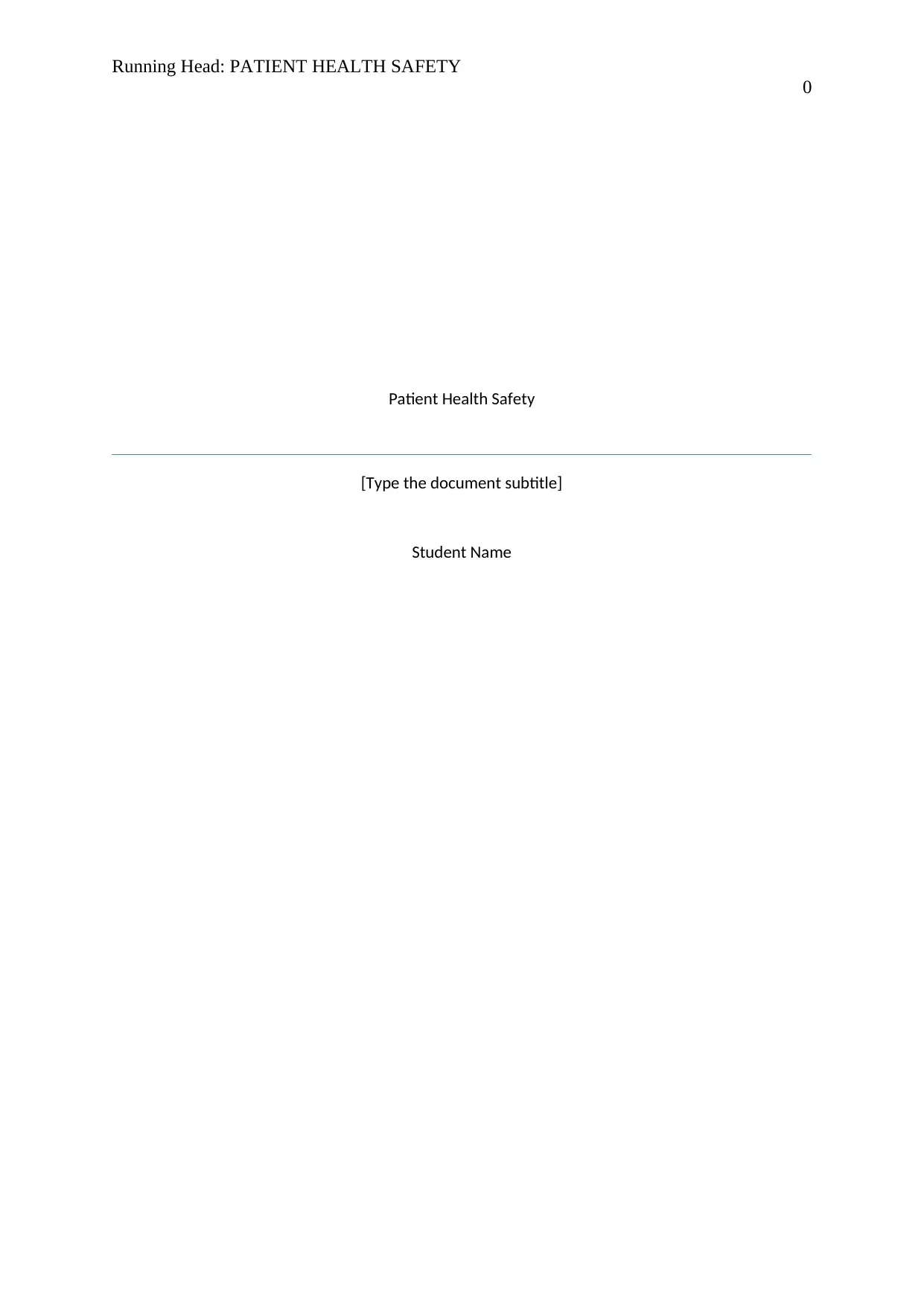
Running Head: PATIENT HEALTH SAFETY
0
Patient Health Safety
[Type the document subtitle]
Student Name
0
Patient Health Safety
[Type the document subtitle]
Student Name
Secure Best Marks with AI Grader
Need help grading? Try our AI Grader for instant feedback on your assignments.
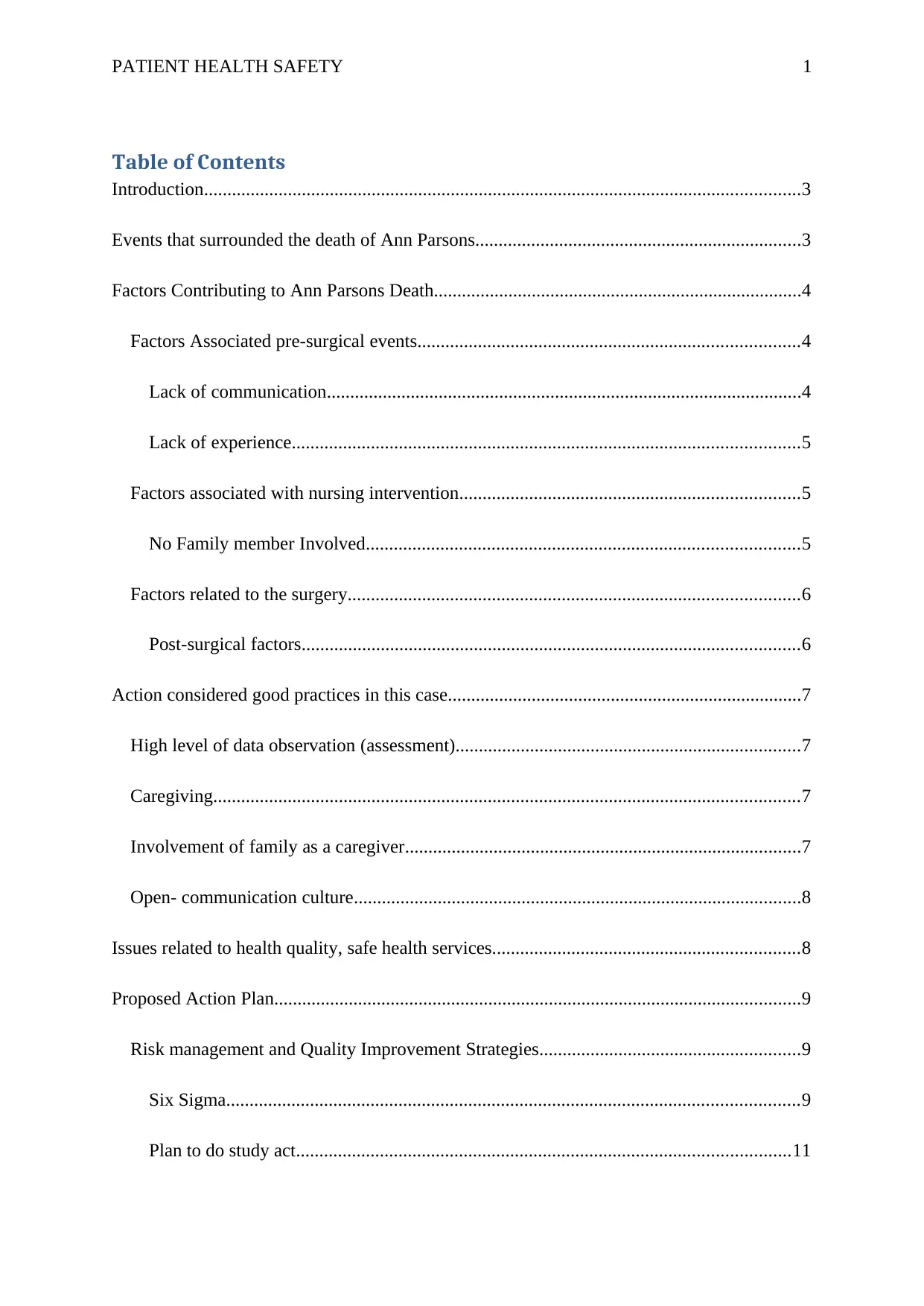
PATIENT HEALTH SAFETY 1
Table of Contents
Introduction................................................................................................................................3
Events that surrounded the death of Ann Parsons......................................................................3
Factors Contributing to Ann Parsons Death...............................................................................4
Factors Associated pre-surgical events..................................................................................4
Lack of communication......................................................................................................4
Lack of experience.............................................................................................................5
Factors associated with nursing intervention.........................................................................5
No Family member Involved.............................................................................................5
Factors related to the surgery.................................................................................................6
Post-surgical factors...........................................................................................................6
Action considered good practices in this case............................................................................7
High level of data observation (assessment)..........................................................................7
Caregiving..............................................................................................................................7
Involvement of family as a caregiver.....................................................................................7
Open- communication culture................................................................................................8
Issues related to health quality, safe health services..................................................................8
Proposed Action Plan.................................................................................................................9
Risk management and Quality Improvement Strategies........................................................9
Six Sigma...........................................................................................................................9
Plan to do study act..........................................................................................................11
Table of Contents
Introduction................................................................................................................................3
Events that surrounded the death of Ann Parsons......................................................................3
Factors Contributing to Ann Parsons Death...............................................................................4
Factors Associated pre-surgical events..................................................................................4
Lack of communication......................................................................................................4
Lack of experience.............................................................................................................5
Factors associated with nursing intervention.........................................................................5
No Family member Involved.............................................................................................5
Factors related to the surgery.................................................................................................6
Post-surgical factors...........................................................................................................6
Action considered good practices in this case............................................................................7
High level of data observation (assessment)..........................................................................7
Caregiving..............................................................................................................................7
Involvement of family as a caregiver.....................................................................................7
Open- communication culture................................................................................................8
Issues related to health quality, safe health services..................................................................8
Proposed Action Plan.................................................................................................................9
Risk management and Quality Improvement Strategies........................................................9
Six Sigma...........................................................................................................................9
Plan to do study act..........................................................................................................11
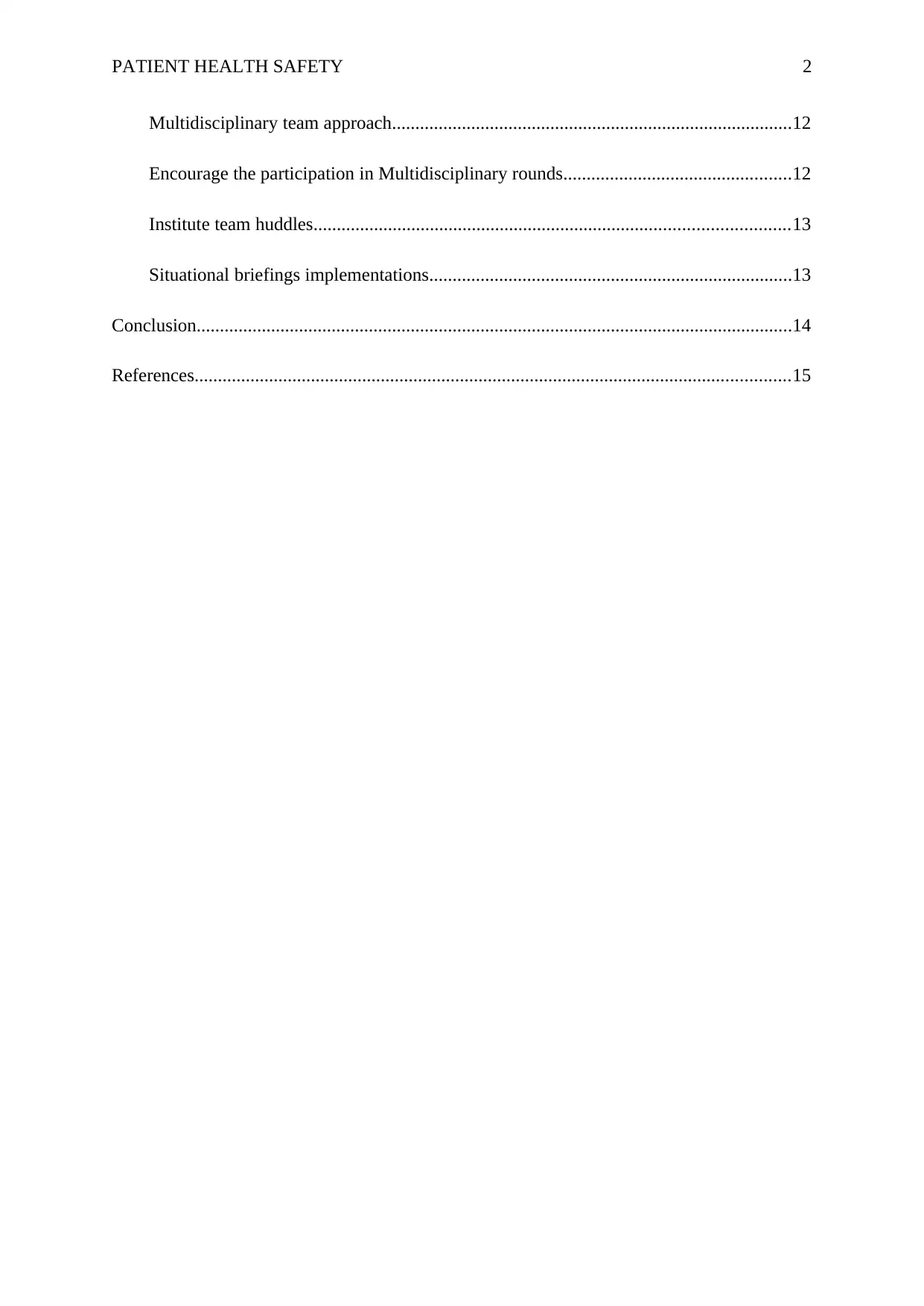
PATIENT HEALTH SAFETY 2
Multidisciplinary team approach......................................................................................12
Encourage the participation in Multidisciplinary rounds.................................................12
Institute team huddles......................................................................................................13
Situational briefings implementations..............................................................................13
Conclusion................................................................................................................................14
References................................................................................................................................15
Multidisciplinary team approach......................................................................................12
Encourage the participation in Multidisciplinary rounds.................................................12
Institute team huddles......................................................................................................13
Situational briefings implementations..............................................................................13
Conclusion................................................................................................................................14
References................................................................................................................................15
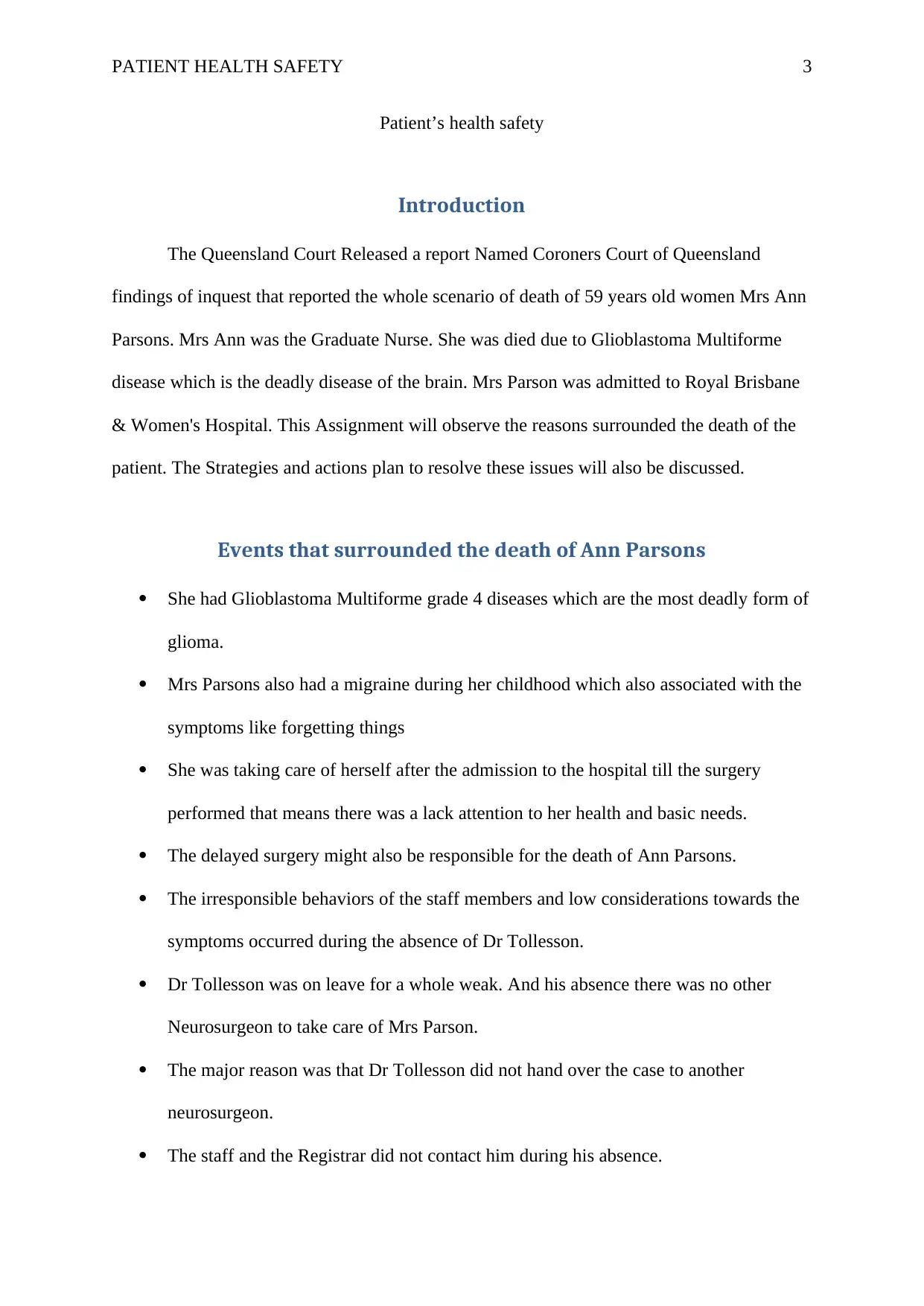
PATIENT HEALTH SAFETY 3
Patient’s health safety
Introduction
The Queensland Court Released a report Named Coroners Court of Queensland
findings of inquest that reported the whole scenario of death of 59 years old women Mrs Ann
Parsons. Mrs Ann was the Graduate Nurse. She was died due to Glioblastoma Multiforme
disease which is the deadly disease of the brain. Mrs Parson was admitted to Royal Brisbane
& Women's Hospital. This Assignment will observe the reasons surrounded the death of the
patient. The Strategies and actions plan to resolve these issues will also be discussed.
Events that surrounded the death of Ann Parsons
She had Glioblastoma Multiforme grade 4 diseases which are the most deadly form of
glioma.
Mrs Parsons also had a migraine during her childhood which also associated with the
symptoms like forgetting things
She was taking care of herself after the admission to the hospital till the surgery
performed that means there was a lack attention to her health and basic needs.
The delayed surgery might also be responsible for the death of Ann Parsons.
The irresponsible behaviors of the staff members and low considerations towards the
symptoms occurred during the absence of Dr Tollesson.
Dr Tollesson was on leave for a whole weak. And his absence there was no other
Neurosurgeon to take care of Mrs Parson.
The major reason was that Dr Tollesson did not hand over the case to another
neurosurgeon.
The staff and the Registrar did not contact him during his absence.
Patient’s health safety
Introduction
The Queensland Court Released a report Named Coroners Court of Queensland
findings of inquest that reported the whole scenario of death of 59 years old women Mrs Ann
Parsons. Mrs Ann was the Graduate Nurse. She was died due to Glioblastoma Multiforme
disease which is the deadly disease of the brain. Mrs Parson was admitted to Royal Brisbane
& Women's Hospital. This Assignment will observe the reasons surrounded the death of the
patient. The Strategies and actions plan to resolve these issues will also be discussed.
Events that surrounded the death of Ann Parsons
She had Glioblastoma Multiforme grade 4 diseases which are the most deadly form of
glioma.
Mrs Parsons also had a migraine during her childhood which also associated with the
symptoms like forgetting things
She was taking care of herself after the admission to the hospital till the surgery
performed that means there was a lack attention to her health and basic needs.
The delayed surgery might also be responsible for the death of Ann Parsons.
The irresponsible behaviors of the staff members and low considerations towards the
symptoms occurred during the absence of Dr Tollesson.
Dr Tollesson was on leave for a whole weak. And his absence there was no other
Neurosurgeon to take care of Mrs Parson.
The major reason was that Dr Tollesson did not hand over the case to another
neurosurgeon.
The staff and the Registrar did not contact him during his absence.
Secure Best Marks with AI Grader
Need help grading? Try our AI Grader for instant feedback on your assignments.
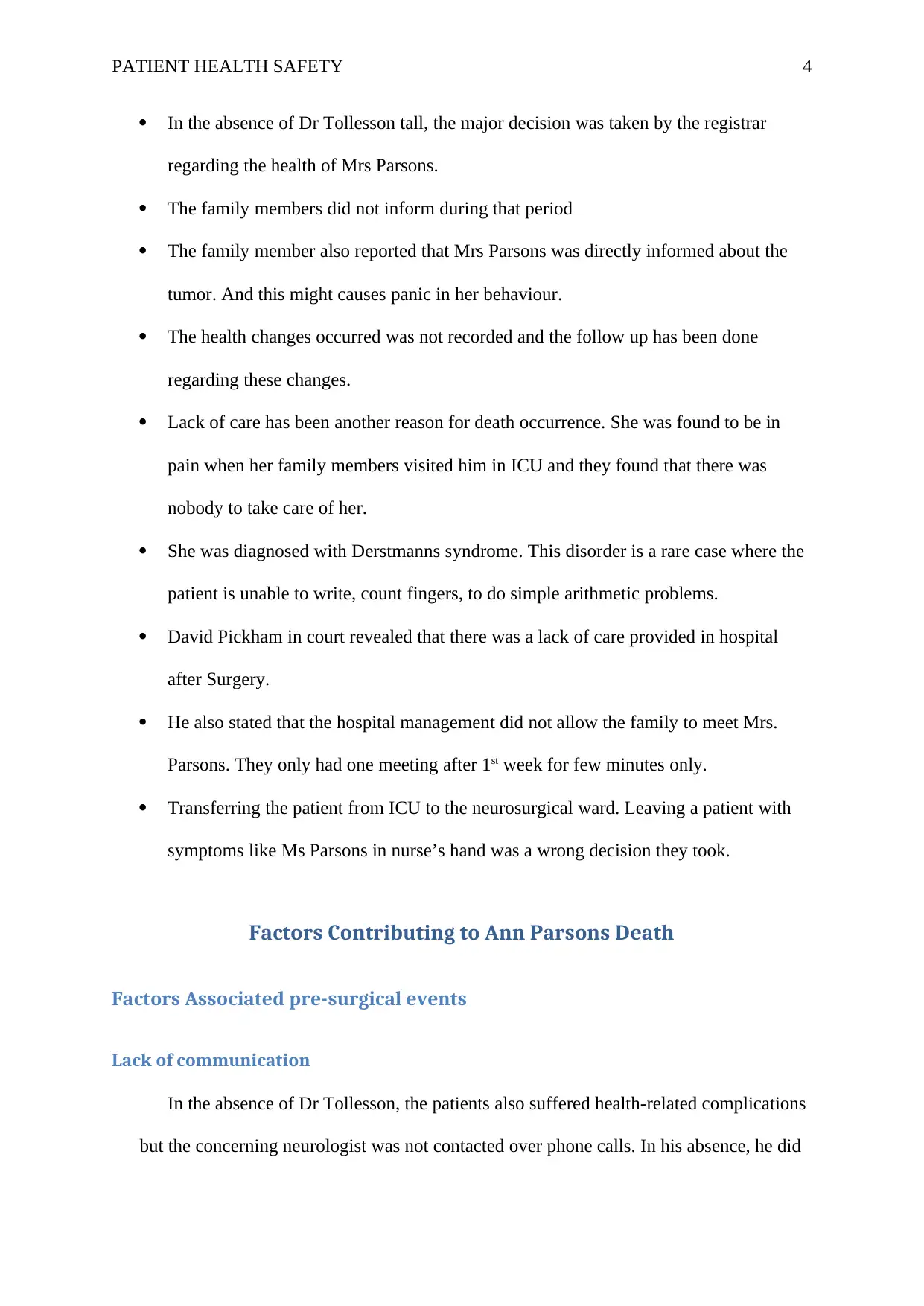
PATIENT HEALTH SAFETY 4
In the absence of Dr Tollesson tall, the major decision was taken by the registrar
regarding the health of Mrs Parsons.
The family members did not inform during that period
The family member also reported that Mrs Parsons was directly informed about the
tumor. And this might causes panic in her behaviour.
The health changes occurred was not recorded and the follow up has been done
regarding these changes.
Lack of care has been another reason for death occurrence. She was found to be in
pain when her family members visited him in ICU and they found that there was
nobody to take care of her.
She was diagnosed with Derstmanns syndrome. This disorder is a rare case where the
patient is unable to write, count fingers, to do simple arithmetic problems.
David Pickham in court revealed that there was a lack of care provided in hospital
after Surgery.
He also stated that the hospital management did not allow the family to meet Mrs.
Parsons. They only had one meeting after 1st week for few minutes only.
Transferring the patient from ICU to the neurosurgical ward. Leaving a patient with
symptoms like Ms Parsons in nurse’s hand was a wrong decision they took.
Factors Contributing to Ann Parsons Death
Factors Associated pre-surgical events
Lack of communication
In the absence of Dr Tollesson, the patients also suffered health-related complications
but the concerning neurologist was not contacted over phone calls. In his absence, he did
In the absence of Dr Tollesson tall, the major decision was taken by the registrar
regarding the health of Mrs Parsons.
The family members did not inform during that period
The family member also reported that Mrs Parsons was directly informed about the
tumor. And this might causes panic in her behaviour.
The health changes occurred was not recorded and the follow up has been done
regarding these changes.
Lack of care has been another reason for death occurrence. She was found to be in
pain when her family members visited him in ICU and they found that there was
nobody to take care of her.
She was diagnosed with Derstmanns syndrome. This disorder is a rare case where the
patient is unable to write, count fingers, to do simple arithmetic problems.
David Pickham in court revealed that there was a lack of care provided in hospital
after Surgery.
He also stated that the hospital management did not allow the family to meet Mrs.
Parsons. They only had one meeting after 1st week for few minutes only.
Transferring the patient from ICU to the neurosurgical ward. Leaving a patient with
symptoms like Ms Parsons in nurse’s hand was a wrong decision they took.
Factors Contributing to Ann Parsons Death
Factors Associated pre-surgical events
Lack of communication
In the absence of Dr Tollesson, the patients also suffered health-related complications
but the concerning neurologist was not contacted over phone calls. In his absence, he did
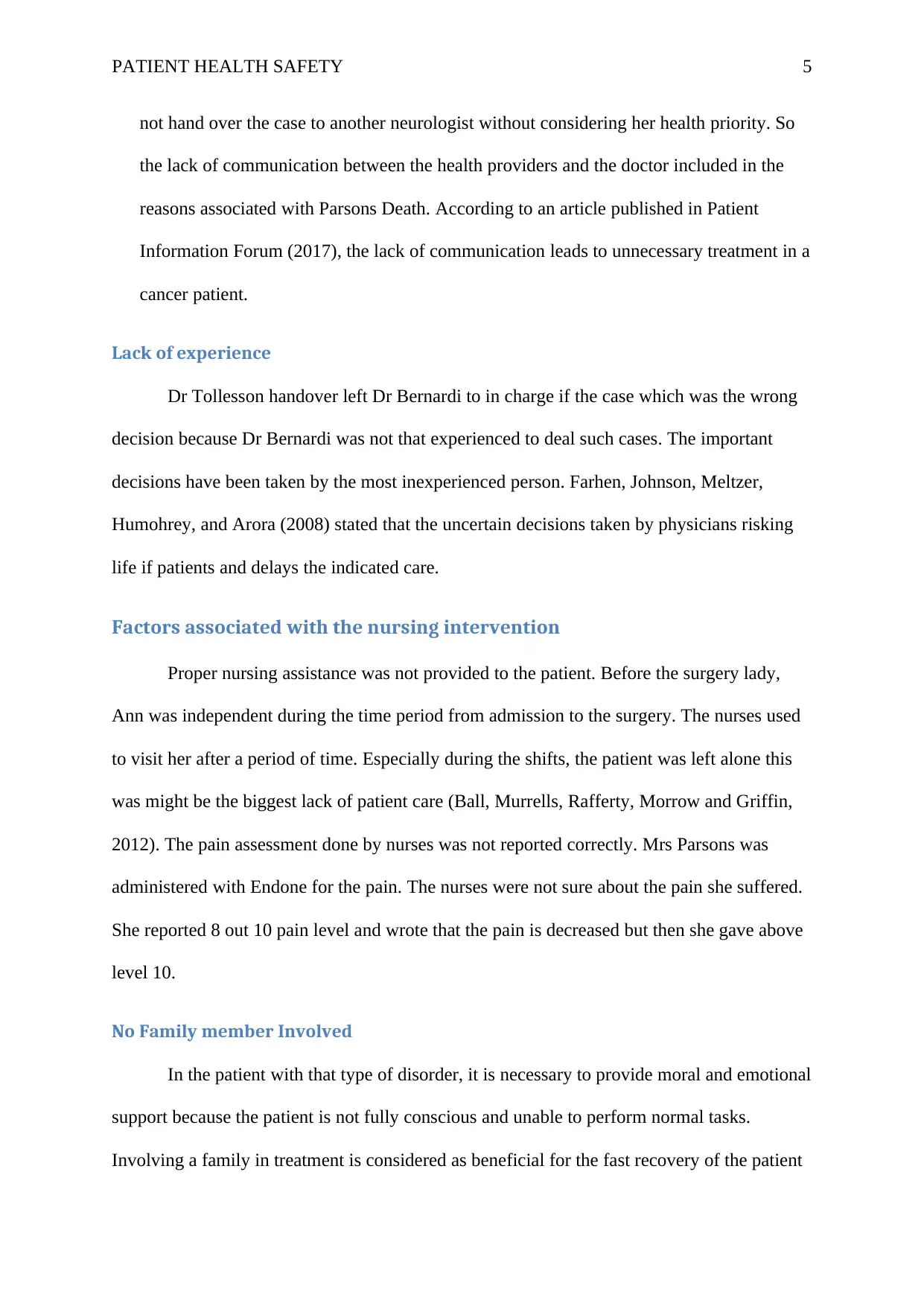
PATIENT HEALTH SAFETY 5
not hand over the case to another neurologist without considering her health priority. So
the lack of communication between the health providers and the doctor included in the
reasons associated with Parsons Death. According to an article published in Patient
Information Forum (2017), the lack of communication leads to unnecessary treatment in a
cancer patient.
Lack of experience
Dr Tollesson handover left Dr Bernardi to in charge if the case which was the wrong
decision because Dr Bernardi was not that experienced to deal such cases. The important
decisions have been taken by the most inexperienced person. Farhen, Johnson, Meltzer,
Humohrey, and Arora (2008) stated that the uncertain decisions taken by physicians risking
life if patients and delays the indicated care.
Factors associated with the nursing intervention
Proper nursing assistance was not provided to the patient. Before the surgery lady,
Ann was independent during the time period from admission to the surgery. The nurses used
to visit her after a period of time. Especially during the shifts, the patient was left alone this
was might be the biggest lack of patient care (Ball, Murrells, Rafferty, Morrow and Griffin,
2012). The pain assessment done by nurses was not reported correctly. Mrs Parsons was
administered with Endone for the pain. The nurses were not sure about the pain she suffered.
She reported 8 out 10 pain level and wrote that the pain is decreased but then she gave above
level 10.
No Family member Involved
In the patient with that type of disorder, it is necessary to provide moral and emotional
support because the patient is not fully conscious and unable to perform normal tasks.
Involving a family in treatment is considered as beneficial for the fast recovery of the patient
not hand over the case to another neurologist without considering her health priority. So
the lack of communication between the health providers and the doctor included in the
reasons associated with Parsons Death. According to an article published in Patient
Information Forum (2017), the lack of communication leads to unnecessary treatment in a
cancer patient.
Lack of experience
Dr Tollesson handover left Dr Bernardi to in charge if the case which was the wrong
decision because Dr Bernardi was not that experienced to deal such cases. The important
decisions have been taken by the most inexperienced person. Farhen, Johnson, Meltzer,
Humohrey, and Arora (2008) stated that the uncertain decisions taken by physicians risking
life if patients and delays the indicated care.
Factors associated with the nursing intervention
Proper nursing assistance was not provided to the patient. Before the surgery lady,
Ann was independent during the time period from admission to the surgery. The nurses used
to visit her after a period of time. Especially during the shifts, the patient was left alone this
was might be the biggest lack of patient care (Ball, Murrells, Rafferty, Morrow and Griffin,
2012). The pain assessment done by nurses was not reported correctly. Mrs Parsons was
administered with Endone for the pain. The nurses were not sure about the pain she suffered.
She reported 8 out 10 pain level and wrote that the pain is decreased but then she gave above
level 10.
No Family member Involved
In the patient with that type of disorder, it is necessary to provide moral and emotional
support because the patient is not fully conscious and unable to perform normal tasks.
Involving a family in treatment is considered as beneficial for the fast recovery of the patient
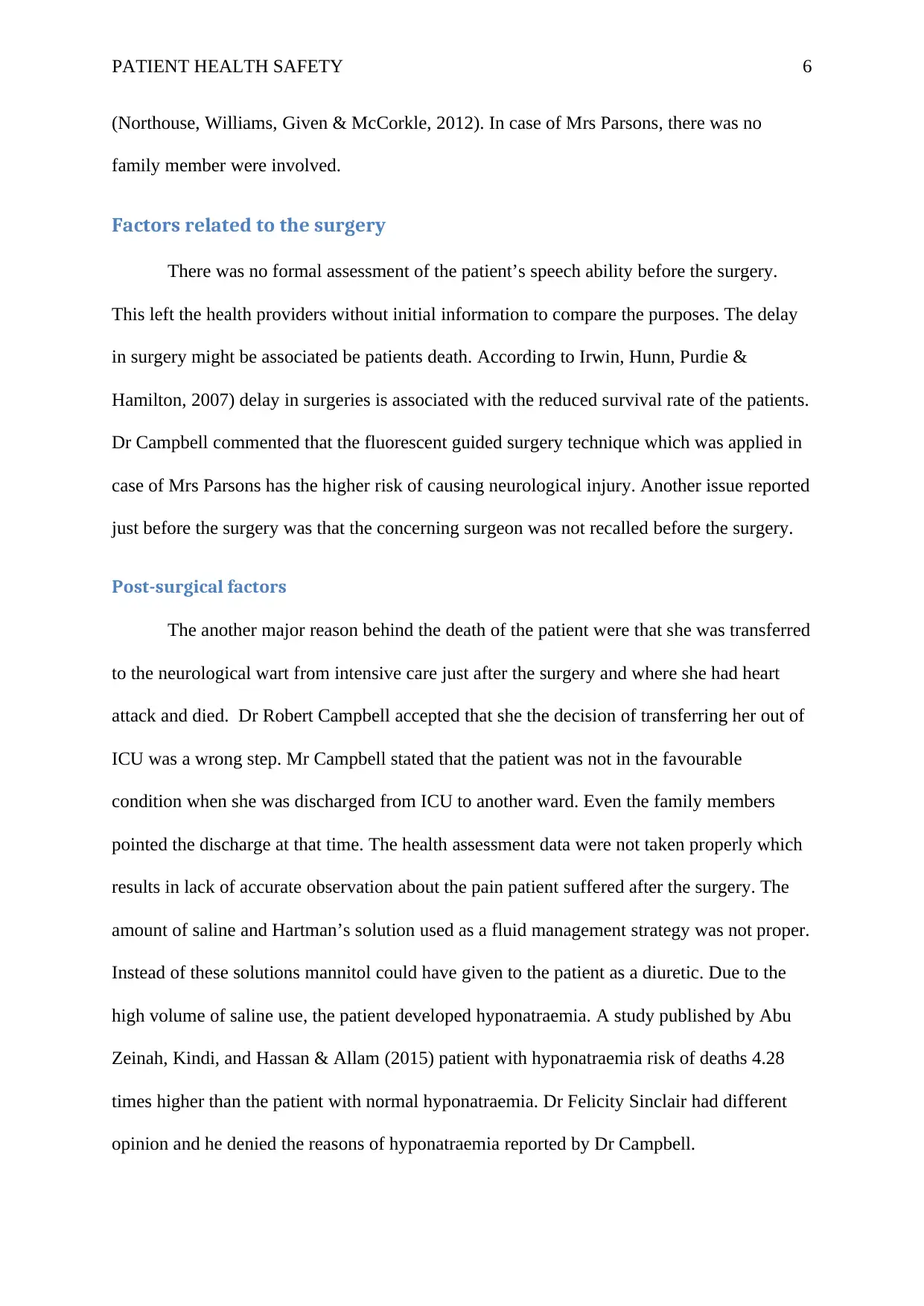
PATIENT HEALTH SAFETY 6
(Northouse, Williams, Given & McCorkle, 2012). In case of Mrs Parsons, there was no
family member were involved.
Factors related to the surgery
There was no formal assessment of the patient’s speech ability before the surgery.
This left the health providers without initial information to compare the purposes. The delay
in surgery might be associated be patients death. According to Irwin, Hunn, Purdie &
Hamilton, 2007) delay in surgeries is associated with the reduced survival rate of the patients.
Dr Campbell commented that the fluorescent guided surgery technique which was applied in
case of Mrs Parsons has the higher risk of causing neurological injury. Another issue reported
just before the surgery was that the concerning surgeon was not recalled before the surgery.
Post-surgical factors
The another major reason behind the death of the patient were that she was transferred
to the neurological wart from intensive care just after the surgery and where she had heart
attack and died. Dr Robert Campbell accepted that she the decision of transferring her out of
ICU was a wrong step. Mr Campbell stated that the patient was not in the favourable
condition when she was discharged from ICU to another ward. Even the family members
pointed the discharge at that time. The health assessment data were not taken properly which
results in lack of accurate observation about the pain patient suffered after the surgery. The
amount of saline and Hartman’s solution used as a fluid management strategy was not proper.
Instead of these solutions mannitol could have given to the patient as a diuretic. Due to the
high volume of saline use, the patient developed hyponatraemia. A study published by Abu
Zeinah, Kindi, and Hassan & Allam (2015) patient with hyponatraemia risk of deaths 4.28
times higher than the patient with normal hyponatraemia. Dr Felicity Sinclair had different
opinion and he denied the reasons of hyponatraemia reported by Dr Campbell.
(Northouse, Williams, Given & McCorkle, 2012). In case of Mrs Parsons, there was no
family member were involved.
Factors related to the surgery
There was no formal assessment of the patient’s speech ability before the surgery.
This left the health providers without initial information to compare the purposes. The delay
in surgery might be associated be patients death. According to Irwin, Hunn, Purdie &
Hamilton, 2007) delay in surgeries is associated with the reduced survival rate of the patients.
Dr Campbell commented that the fluorescent guided surgery technique which was applied in
case of Mrs Parsons has the higher risk of causing neurological injury. Another issue reported
just before the surgery was that the concerning surgeon was not recalled before the surgery.
Post-surgical factors
The another major reason behind the death of the patient were that she was transferred
to the neurological wart from intensive care just after the surgery and where she had heart
attack and died. Dr Robert Campbell accepted that she the decision of transferring her out of
ICU was a wrong step. Mr Campbell stated that the patient was not in the favourable
condition when she was discharged from ICU to another ward. Even the family members
pointed the discharge at that time. The health assessment data were not taken properly which
results in lack of accurate observation about the pain patient suffered after the surgery. The
amount of saline and Hartman’s solution used as a fluid management strategy was not proper.
Instead of these solutions mannitol could have given to the patient as a diuretic. Due to the
high volume of saline use, the patient developed hyponatraemia. A study published by Abu
Zeinah, Kindi, and Hassan & Allam (2015) patient with hyponatraemia risk of deaths 4.28
times higher than the patient with normal hyponatraemia. Dr Felicity Sinclair had different
opinion and he denied the reasons of hyponatraemia reported by Dr Campbell.
Paraphrase This Document
Need a fresh take? Get an instant paraphrase of this document with our AI Paraphraser
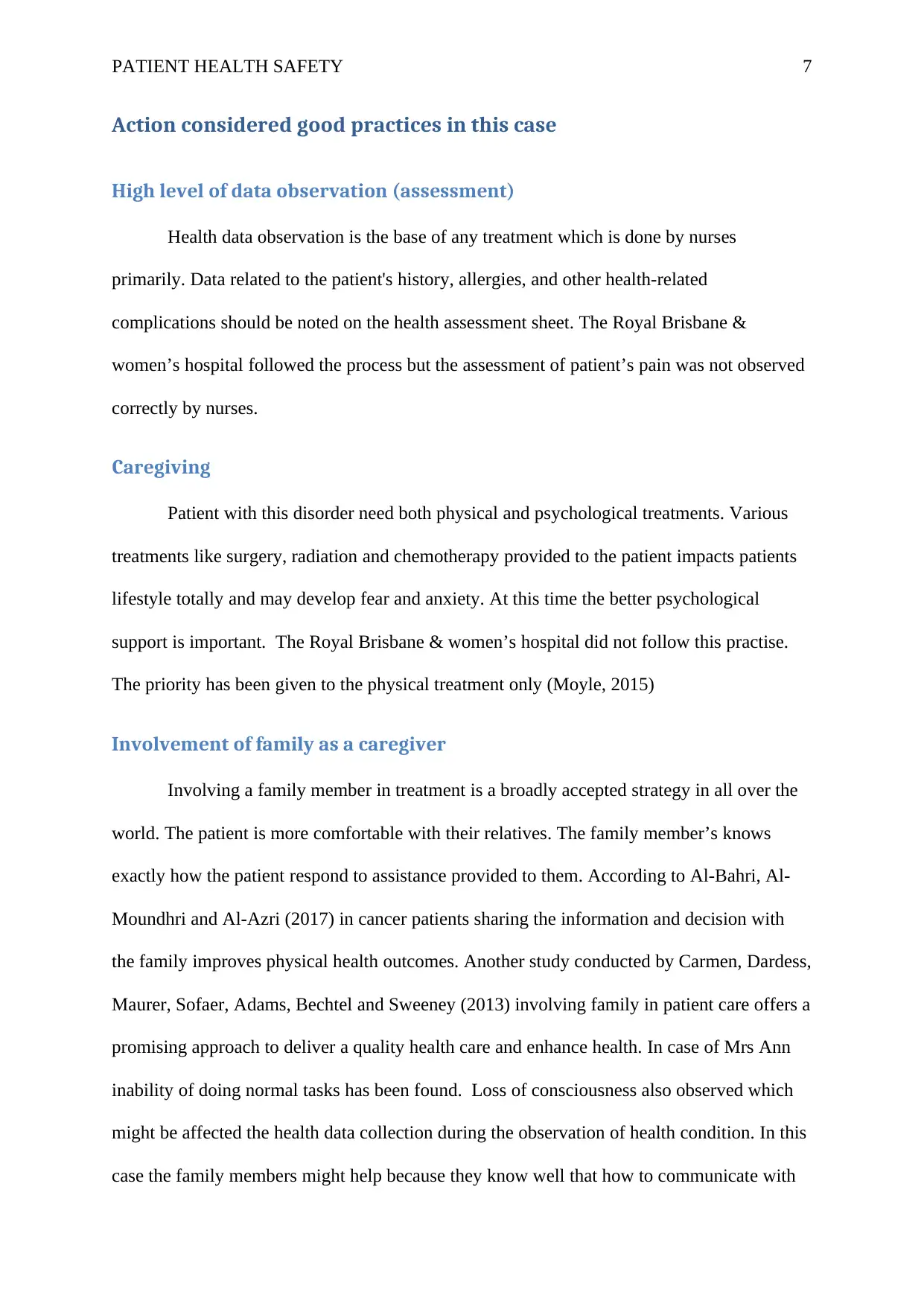
PATIENT HEALTH SAFETY 7
Action considered good practices in this case
High level of data observation (assessment)
Health data observation is the base of any treatment which is done by nurses
primarily. Data related to the patient's history, allergies, and other health-related
complications should be noted on the health assessment sheet. The Royal Brisbane &
women’s hospital followed the process but the assessment of patient’s pain was not observed
correctly by nurses.
Caregiving
Patient with this disorder need both physical and psychological treatments. Various
treatments like surgery, radiation and chemotherapy provided to the patient impacts patients
lifestyle totally and may develop fear and anxiety. At this time the better psychological
support is important. The Royal Brisbane & women’s hospital did not follow this practise.
The priority has been given to the physical treatment only (Moyle, 2015)
Involvement of family as a caregiver
Involving a family member in treatment is a broadly accepted strategy in all over the
world. The patient is more comfortable with their relatives. The family member’s knows
exactly how the patient respond to assistance provided to them. According to Al-Bahri, Al-
Moundhri and Al-Azri (2017) in cancer patients sharing the information and decision with
the family improves physical health outcomes. Another study conducted by Carmen, Dardess,
Maurer, Sofaer, Adams, Bechtel and Sweeney (2013) involving family in patient care offers a
promising approach to deliver a quality health care and enhance health. In case of Mrs Ann
inability of doing normal tasks has been found. Loss of consciousness also observed which
might be affected the health data collection during the observation of health condition. In this
case the family members might help because they know well that how to communicate with
Action considered good practices in this case
High level of data observation (assessment)
Health data observation is the base of any treatment which is done by nurses
primarily. Data related to the patient's history, allergies, and other health-related
complications should be noted on the health assessment sheet. The Royal Brisbane &
women’s hospital followed the process but the assessment of patient’s pain was not observed
correctly by nurses.
Caregiving
Patient with this disorder need both physical and psychological treatments. Various
treatments like surgery, radiation and chemotherapy provided to the patient impacts patients
lifestyle totally and may develop fear and anxiety. At this time the better psychological
support is important. The Royal Brisbane & women’s hospital did not follow this practise.
The priority has been given to the physical treatment only (Moyle, 2015)
Involvement of family as a caregiver
Involving a family member in treatment is a broadly accepted strategy in all over the
world. The patient is more comfortable with their relatives. The family member’s knows
exactly how the patient respond to assistance provided to them. According to Al-Bahri, Al-
Moundhri and Al-Azri (2017) in cancer patients sharing the information and decision with
the family improves physical health outcomes. Another study conducted by Carmen, Dardess,
Maurer, Sofaer, Adams, Bechtel and Sweeney (2013) involving family in patient care offers a
promising approach to deliver a quality health care and enhance health. In case of Mrs Ann
inability of doing normal tasks has been found. Loss of consciousness also observed which
might be affected the health data collection during the observation of health condition. In this
case the family members might help because they know well that how to communicate with
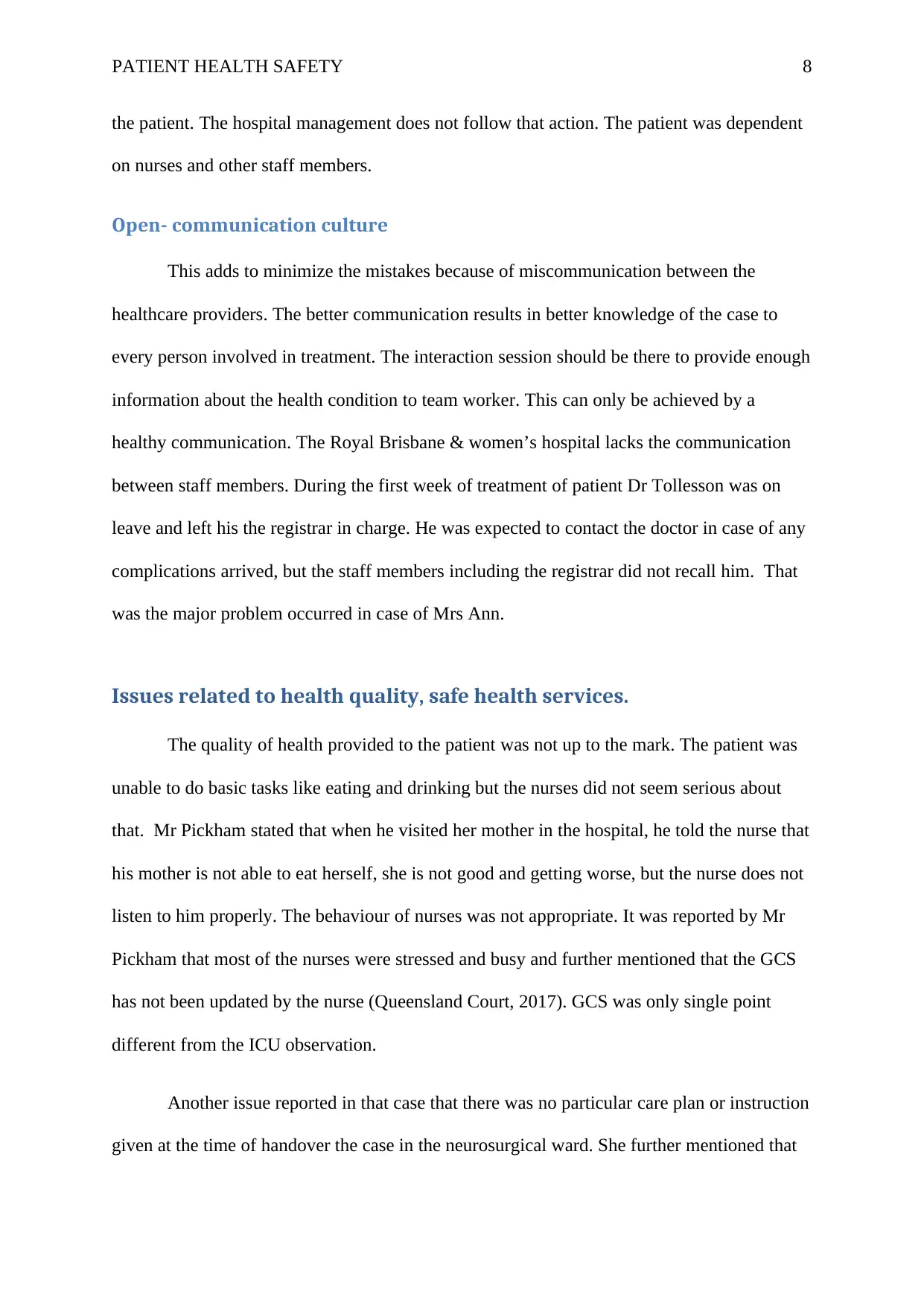
PATIENT HEALTH SAFETY 8
the patient. The hospital management does not follow that action. The patient was dependent
on nurses and other staff members.
Open- communication culture
This adds to minimize the mistakes because of miscommunication between the
healthcare providers. The better communication results in better knowledge of the case to
every person involved in treatment. The interaction session should be there to provide enough
information about the health condition to team worker. This can only be achieved by a
healthy communication. The Royal Brisbane & women’s hospital lacks the communication
between staff members. During the first week of treatment of patient Dr Tollesson was on
leave and left his the registrar in charge. He was expected to contact the doctor in case of any
complications arrived, but the staff members including the registrar did not recall him. That
was the major problem occurred in case of Mrs Ann.
Issues related to health quality, safe health services.
The quality of health provided to the patient was not up to the mark. The patient was
unable to do basic tasks like eating and drinking but the nurses did not seem serious about
that. Mr Pickham stated that when he visited her mother in the hospital, he told the nurse that
his mother is not able to eat herself, she is not good and getting worse, but the nurse does not
listen to him properly. The behaviour of nurses was not appropriate. It was reported by Mr
Pickham that most of the nurses were stressed and busy and further mentioned that the GCS
has not been updated by the nurse (Queensland Court, 2017). GCS was only single point
different from the ICU observation.
Another issue reported in that case that there was no particular care plan or instruction
given at the time of handover the case in the neurosurgical ward. She further mentioned that
the patient. The hospital management does not follow that action. The patient was dependent
on nurses and other staff members.
Open- communication culture
This adds to minimize the mistakes because of miscommunication between the
healthcare providers. The better communication results in better knowledge of the case to
every person involved in treatment. The interaction session should be there to provide enough
information about the health condition to team worker. This can only be achieved by a
healthy communication. The Royal Brisbane & women’s hospital lacks the communication
between staff members. During the first week of treatment of patient Dr Tollesson was on
leave and left his the registrar in charge. He was expected to contact the doctor in case of any
complications arrived, but the staff members including the registrar did not recall him. That
was the major problem occurred in case of Mrs Ann.
Issues related to health quality, safe health services.
The quality of health provided to the patient was not up to the mark. The patient was
unable to do basic tasks like eating and drinking but the nurses did not seem serious about
that. Mr Pickham stated that when he visited her mother in the hospital, he told the nurse that
his mother is not able to eat herself, she is not good and getting worse, but the nurse does not
listen to him properly. The behaviour of nurses was not appropriate. It was reported by Mr
Pickham that most of the nurses were stressed and busy and further mentioned that the GCS
has not been updated by the nurse (Queensland Court, 2017). GCS was only single point
different from the ICU observation.
Another issue reported in that case that there was no particular care plan or instruction
given at the time of handover the case in the neurosurgical ward. She further mentioned that
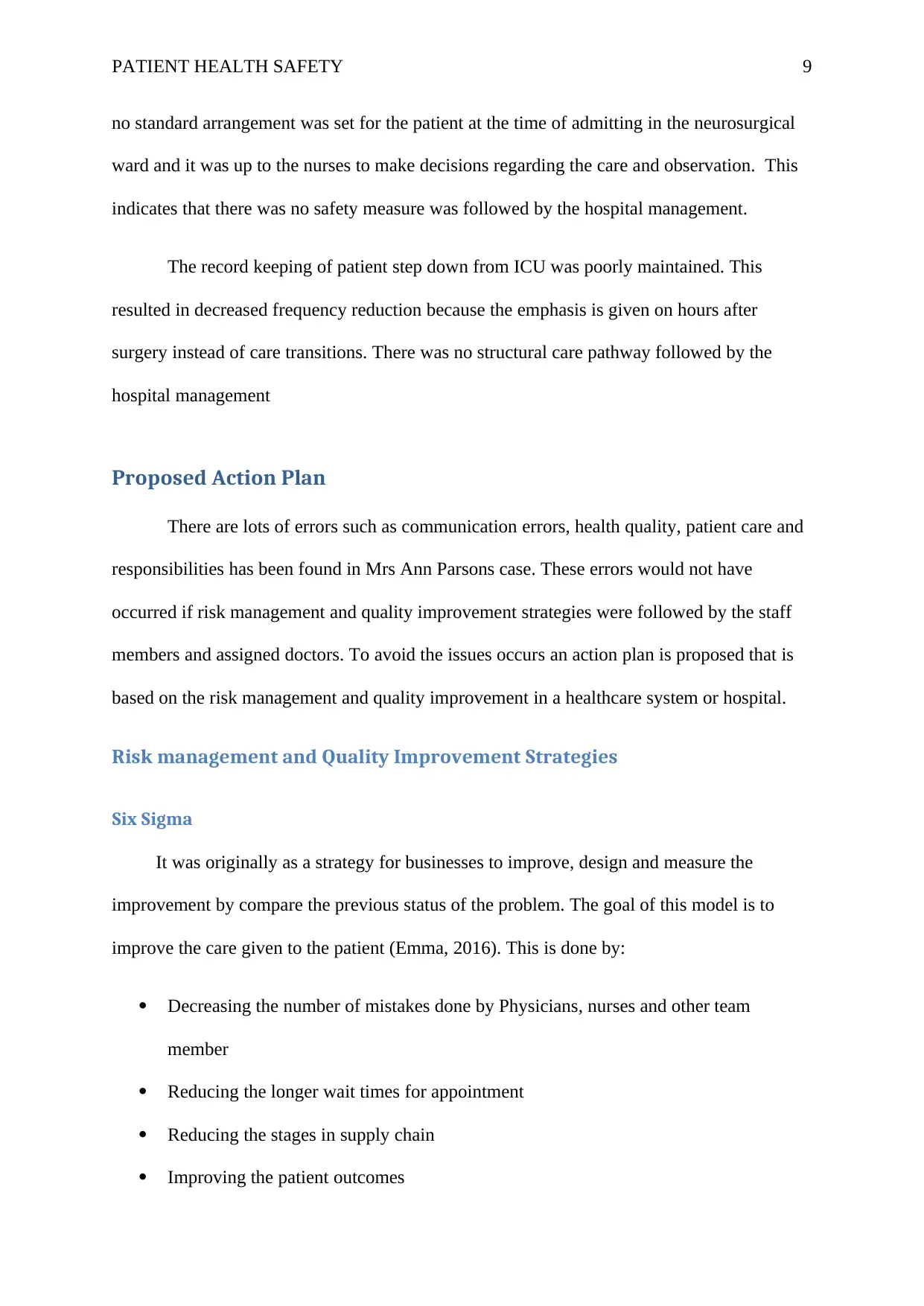
PATIENT HEALTH SAFETY 9
no standard arrangement was set for the patient at the time of admitting in the neurosurgical
ward and it was up to the nurses to make decisions regarding the care and observation. This
indicates that there was no safety measure was followed by the hospital management.
The record keeping of patient step down from ICU was poorly maintained. This
resulted in decreased frequency reduction because the emphasis is given on hours after
surgery instead of care transitions. There was no structural care pathway followed by the
hospital management
Proposed Action Plan
There are lots of errors such as communication errors, health quality, patient care and
responsibilities has been found in Mrs Ann Parsons case. These errors would not have
occurred if risk management and quality improvement strategies were followed by the staff
members and assigned doctors. To avoid the issues occurs an action plan is proposed that is
based on the risk management and quality improvement in a healthcare system or hospital.
Risk management and Quality Improvement Strategies
Six Sigma
It was originally as a strategy for businesses to improve, design and measure the
improvement by compare the previous status of the problem. The goal of this model is to
improve the care given to the patient (Emma, 2016). This is done by:
Decreasing the number of mistakes done by Physicians, nurses and other team
member
Reducing the longer wait times for appointment
Reducing the stages in supply chain
Improving the patient outcomes
no standard arrangement was set for the patient at the time of admitting in the neurosurgical
ward and it was up to the nurses to make decisions regarding the care and observation. This
indicates that there was no safety measure was followed by the hospital management.
The record keeping of patient step down from ICU was poorly maintained. This
resulted in decreased frequency reduction because the emphasis is given on hours after
surgery instead of care transitions. There was no structural care pathway followed by the
hospital management
Proposed Action Plan
There are lots of errors such as communication errors, health quality, patient care and
responsibilities has been found in Mrs Ann Parsons case. These errors would not have
occurred if risk management and quality improvement strategies were followed by the staff
members and assigned doctors. To avoid the issues occurs an action plan is proposed that is
based on the risk management and quality improvement in a healthcare system or hospital.
Risk management and Quality Improvement Strategies
Six Sigma
It was originally as a strategy for businesses to improve, design and measure the
improvement by compare the previous status of the problem. The goal of this model is to
improve the care given to the patient (Emma, 2016). This is done by:
Decreasing the number of mistakes done by Physicians, nurses and other team
member
Reducing the longer wait times for appointment
Reducing the stages in supply chain
Improving the patient outcomes
Secure Best Marks with AI Grader
Need help grading? Try our AI Grader for instant feedback on your assignments.
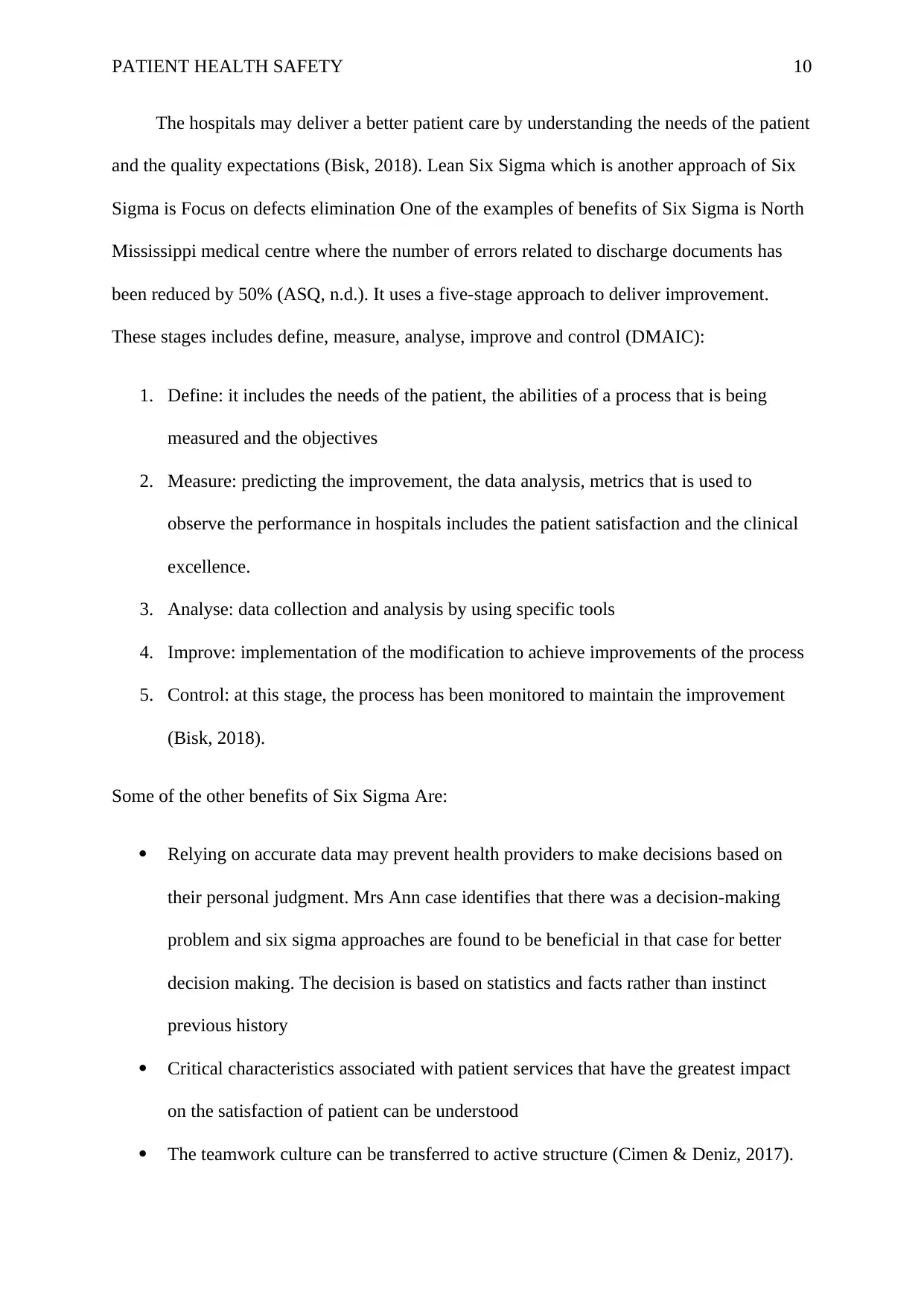
PATIENT HEALTH SAFETY 10
The hospitals may deliver a better patient care by understanding the needs of the patient
and the quality expectations (Bisk, 2018). Lean Six Sigma which is another approach of Six
Sigma is Focus on defects elimination One of the examples of benefits of Six Sigma is North
Mississippi medical centre where the number of errors related to discharge documents has
been reduced by 50% (ASQ, n.d.). It uses a five-stage approach to deliver improvement.
These stages includes define, measure, analyse, improve and control (DMAIC):
1. Define: it includes the needs of the patient, the abilities of a process that is being
measured and the objectives
2. Measure: predicting the improvement, the data analysis, metrics that is used to
observe the performance in hospitals includes the patient satisfaction and the clinical
excellence.
3. Analyse: data collection and analysis by using specific tools
4. Improve: implementation of the modification to achieve improvements of the process
5. Control: at this stage, the process has been monitored to maintain the improvement
(Bisk, 2018).
Some of the other benefits of Six Sigma Are:
Relying on accurate data may prevent health providers to make decisions based on
their personal judgment. Mrs Ann case identifies that there was a decision-making
problem and six sigma approaches are found to be beneficial in that case for better
decision making. The decision is based on statistics and facts rather than instinct
previous history
Critical characteristics associated with patient services that have the greatest impact
on the satisfaction of patient can be understood
The teamwork culture can be transferred to active structure (Cimen & Deniz, 2017).
The hospitals may deliver a better patient care by understanding the needs of the patient
and the quality expectations (Bisk, 2018). Lean Six Sigma which is another approach of Six
Sigma is Focus on defects elimination One of the examples of benefits of Six Sigma is North
Mississippi medical centre where the number of errors related to discharge documents has
been reduced by 50% (ASQ, n.d.). It uses a five-stage approach to deliver improvement.
These stages includes define, measure, analyse, improve and control (DMAIC):
1. Define: it includes the needs of the patient, the abilities of a process that is being
measured and the objectives
2. Measure: predicting the improvement, the data analysis, metrics that is used to
observe the performance in hospitals includes the patient satisfaction and the clinical
excellence.
3. Analyse: data collection and analysis by using specific tools
4. Improve: implementation of the modification to achieve improvements of the process
5. Control: at this stage, the process has been monitored to maintain the improvement
(Bisk, 2018).
Some of the other benefits of Six Sigma Are:
Relying on accurate data may prevent health providers to make decisions based on
their personal judgment. Mrs Ann case identifies that there was a decision-making
problem and six sigma approaches are found to be beneficial in that case for better
decision making. The decision is based on statistics and facts rather than instinct
previous history
Critical characteristics associated with patient services that have the greatest impact
on the satisfaction of patient can be understood
The teamwork culture can be transferred to active structure (Cimen & Deniz, 2017).
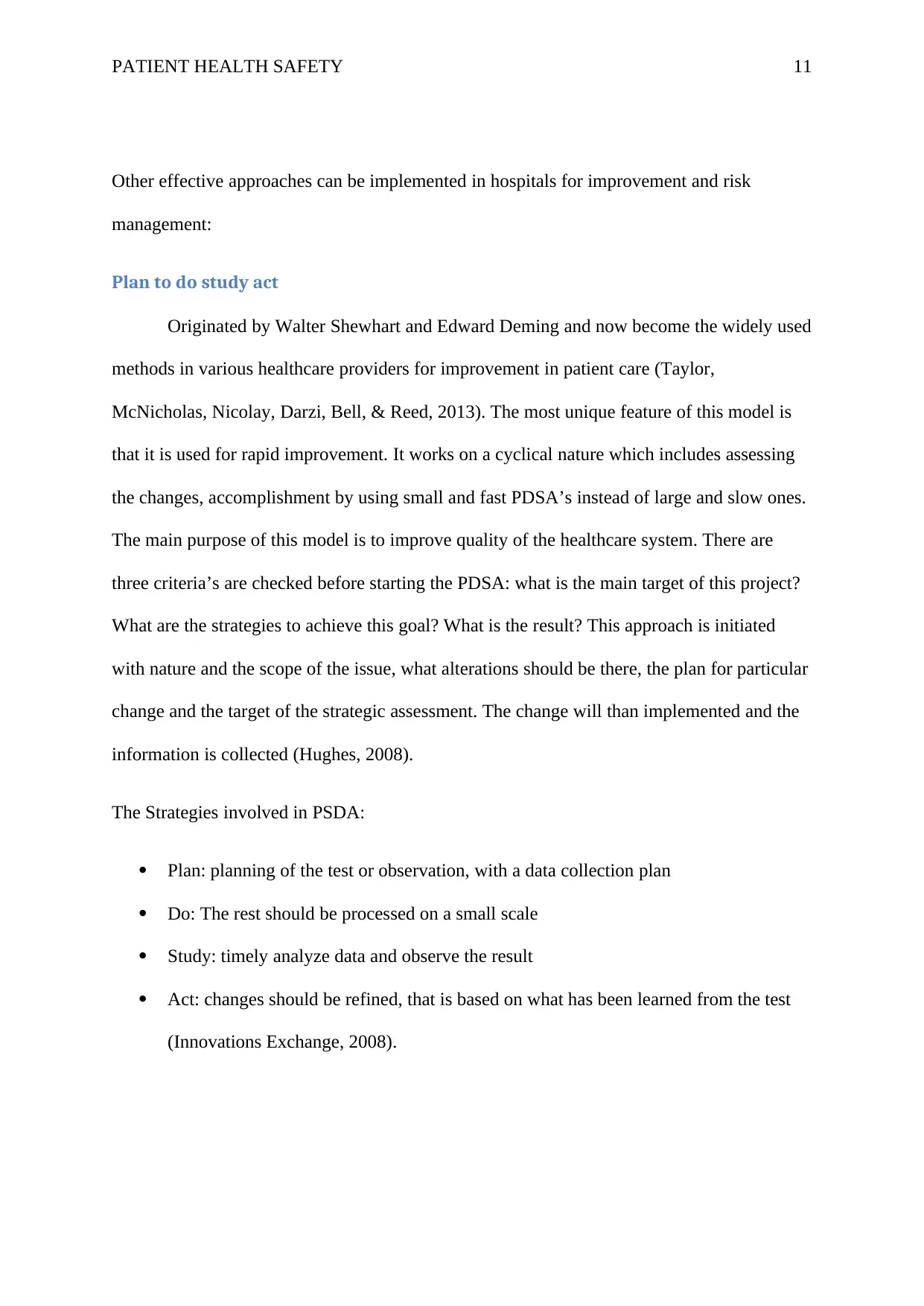
PATIENT HEALTH SAFETY 11
Other effective approaches can be implemented in hospitals for improvement and risk
management:
Plan to do study act
Originated by Walter Shewhart and Edward Deming and now become the widely used
methods in various healthcare providers for improvement in patient care (Taylor,
McNicholas, Nicolay, Darzi, Bell, & Reed, 2013). The most unique feature of this model is
that it is used for rapid improvement. It works on a cyclical nature which includes assessing
the changes, accomplishment by using small and fast PDSA’s instead of large and slow ones.
The main purpose of this model is to improve quality of the healthcare system. There are
three criteria’s are checked before starting the PDSA: what is the main target of this project?
What are the strategies to achieve this goal? What is the result? This approach is initiated
with nature and the scope of the issue, what alterations should be there, the plan for particular
change and the target of the strategic assessment. The change will than implemented and the
information is collected (Hughes, 2008).
The Strategies involved in PSDA:
Plan: planning of the test or observation, with a data collection plan
Do: The rest should be processed on a small scale
Study: timely analyze data and observe the result
Act: changes should be refined, that is based on what has been learned from the test
(Innovations Exchange, 2008).
Other effective approaches can be implemented in hospitals for improvement and risk
management:
Plan to do study act
Originated by Walter Shewhart and Edward Deming and now become the widely used
methods in various healthcare providers for improvement in patient care (Taylor,
McNicholas, Nicolay, Darzi, Bell, & Reed, 2013). The most unique feature of this model is
that it is used for rapid improvement. It works on a cyclical nature which includes assessing
the changes, accomplishment by using small and fast PDSA’s instead of large and slow ones.
The main purpose of this model is to improve quality of the healthcare system. There are
three criteria’s are checked before starting the PDSA: what is the main target of this project?
What are the strategies to achieve this goal? What is the result? This approach is initiated
with nature and the scope of the issue, what alterations should be there, the plan for particular
change and the target of the strategic assessment. The change will than implemented and the
information is collected (Hughes, 2008).
The Strategies involved in PSDA:
Plan: planning of the test or observation, with a data collection plan
Do: The rest should be processed on a small scale
Study: timely analyze data and observe the result
Act: changes should be refined, that is based on what has been learned from the test
(Innovations Exchange, 2008).
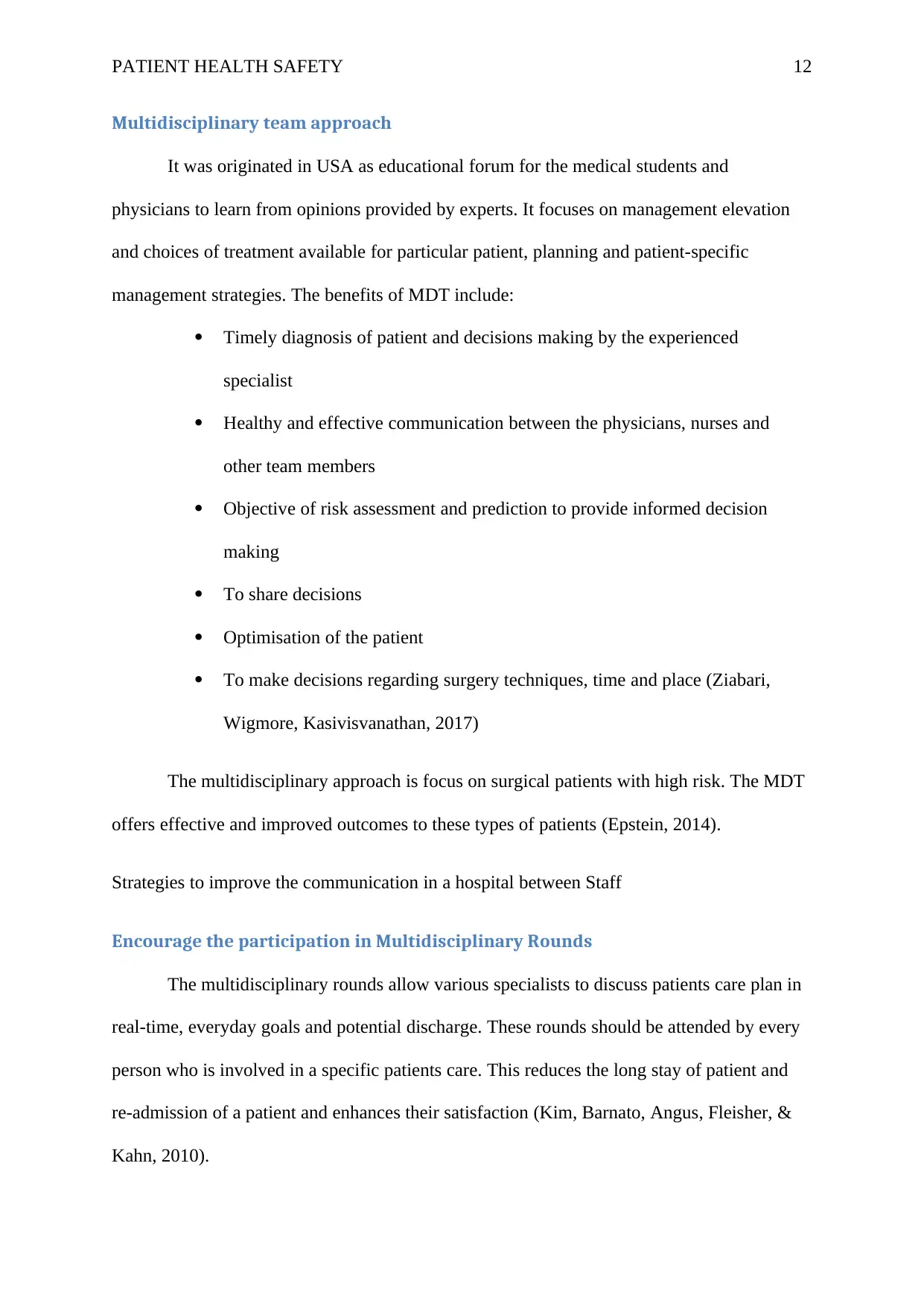
PATIENT HEALTH SAFETY 12
Multidisciplinary team approach
It was originated in USA as educational forum for the medical students and
physicians to learn from opinions provided by experts. It focuses on management elevation
and choices of treatment available for particular patient, planning and patient-specific
management strategies. The benefits of MDT include:
Timely diagnosis of patient and decisions making by the experienced
specialist
Healthy and effective communication between the physicians, nurses and
other team members
Objective of risk assessment and prediction to provide informed decision
making
To share decisions
Optimisation of the patient
To make decisions regarding surgery techniques, time and place (Ziabari,
Wigmore, Kasivisvanathan, 2017)
The multidisciplinary approach is focus on surgical patients with high risk. The MDT
offers effective and improved outcomes to these types of patients (Epstein, 2014).
Strategies to improve the communication in a hospital between Staff
Encourage the participation in Multidisciplinary Rounds
The multidisciplinary rounds allow various specialists to discuss patients care plan in
real-time, everyday goals and potential discharge. These rounds should be attended by every
person who is involved in a specific patients care. This reduces the long stay of patient and
re-admission of a patient and enhances their satisfaction (Kim, Barnato, Angus, Fleisher, &
Kahn, 2010).
Multidisciplinary team approach
It was originated in USA as educational forum for the medical students and
physicians to learn from opinions provided by experts. It focuses on management elevation
and choices of treatment available for particular patient, planning and patient-specific
management strategies. The benefits of MDT include:
Timely diagnosis of patient and decisions making by the experienced
specialist
Healthy and effective communication between the physicians, nurses and
other team members
Objective of risk assessment and prediction to provide informed decision
making
To share decisions
Optimisation of the patient
To make decisions regarding surgery techniques, time and place (Ziabari,
Wigmore, Kasivisvanathan, 2017)
The multidisciplinary approach is focus on surgical patients with high risk. The MDT
offers effective and improved outcomes to these types of patients (Epstein, 2014).
Strategies to improve the communication in a hospital between Staff
Encourage the participation in Multidisciplinary Rounds
The multidisciplinary rounds allow various specialists to discuss patients care plan in
real-time, everyday goals and potential discharge. These rounds should be attended by every
person who is involved in a specific patients care. This reduces the long stay of patient and
re-admission of a patient and enhances their satisfaction (Kim, Barnato, Angus, Fleisher, &
Kahn, 2010).
Paraphrase This Document
Need a fresh take? Get an instant paraphrase of this document with our AI Paraphraser
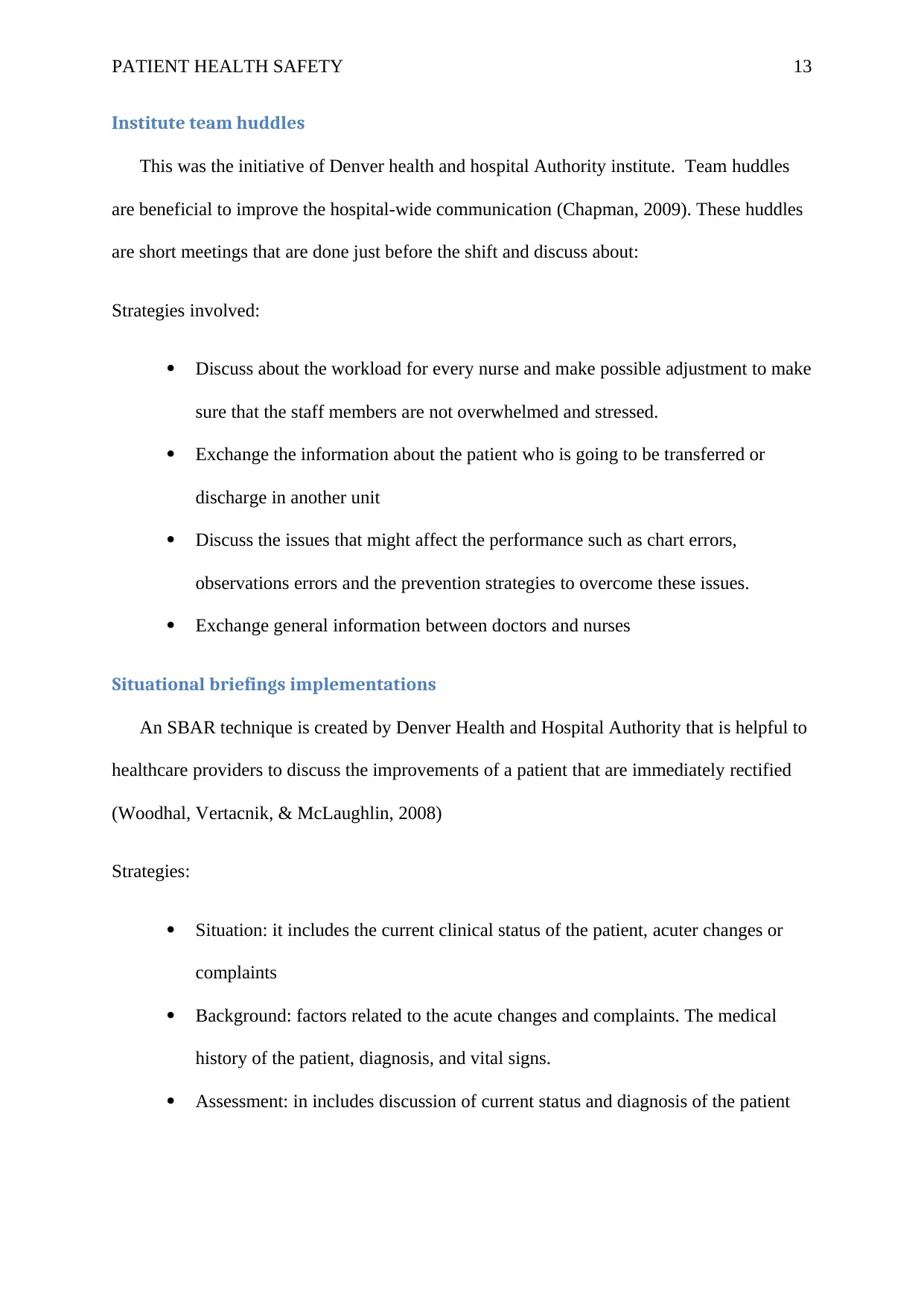
PATIENT HEALTH SAFETY 13
Institute team huddles
This was the initiative of Denver health and hospital Authority institute. Team huddles
are beneficial to improve the hospital-wide communication (Chapman, 2009). These huddles
are short meetings that are done just before the shift and discuss about:
Strategies involved:
Discuss about the workload for every nurse and make possible adjustment to make
sure that the staff members are not overwhelmed and stressed.
Exchange the information about the patient who is going to be transferred or
discharge in another unit
Discuss the issues that might affect the performance such as chart errors,
observations errors and the prevention strategies to overcome these issues.
Exchange general information between doctors and nurses
Situational briefings implementations
An SBAR technique is created by Denver Health and Hospital Authority that is helpful to
healthcare providers to discuss the improvements of a patient that are immediately rectified
(Woodhal, Vertacnik, & McLaughlin, 2008)
Strategies:
Situation: it includes the current clinical status of the patient, acuter changes or
complaints
Background: factors related to the acute changes and complaints. The medical
history of the patient, diagnosis, and vital signs.
Assessment: in includes discussion of current status and diagnosis of the patient
Institute team huddles
This was the initiative of Denver health and hospital Authority institute. Team huddles
are beneficial to improve the hospital-wide communication (Chapman, 2009). These huddles
are short meetings that are done just before the shift and discuss about:
Strategies involved:
Discuss about the workload for every nurse and make possible adjustment to make
sure that the staff members are not overwhelmed and stressed.
Exchange the information about the patient who is going to be transferred or
discharge in another unit
Discuss the issues that might affect the performance such as chart errors,
observations errors and the prevention strategies to overcome these issues.
Exchange general information between doctors and nurses
Situational briefings implementations
An SBAR technique is created by Denver Health and Hospital Authority that is helpful to
healthcare providers to discuss the improvements of a patient that are immediately rectified
(Woodhal, Vertacnik, & McLaughlin, 2008)
Strategies:
Situation: it includes the current clinical status of the patient, acuter changes or
complaints
Background: factors related to the acute changes and complaints. The medical
history of the patient, diagnosis, and vital signs.
Assessment: in includes discussion of current status and diagnosis of the patient
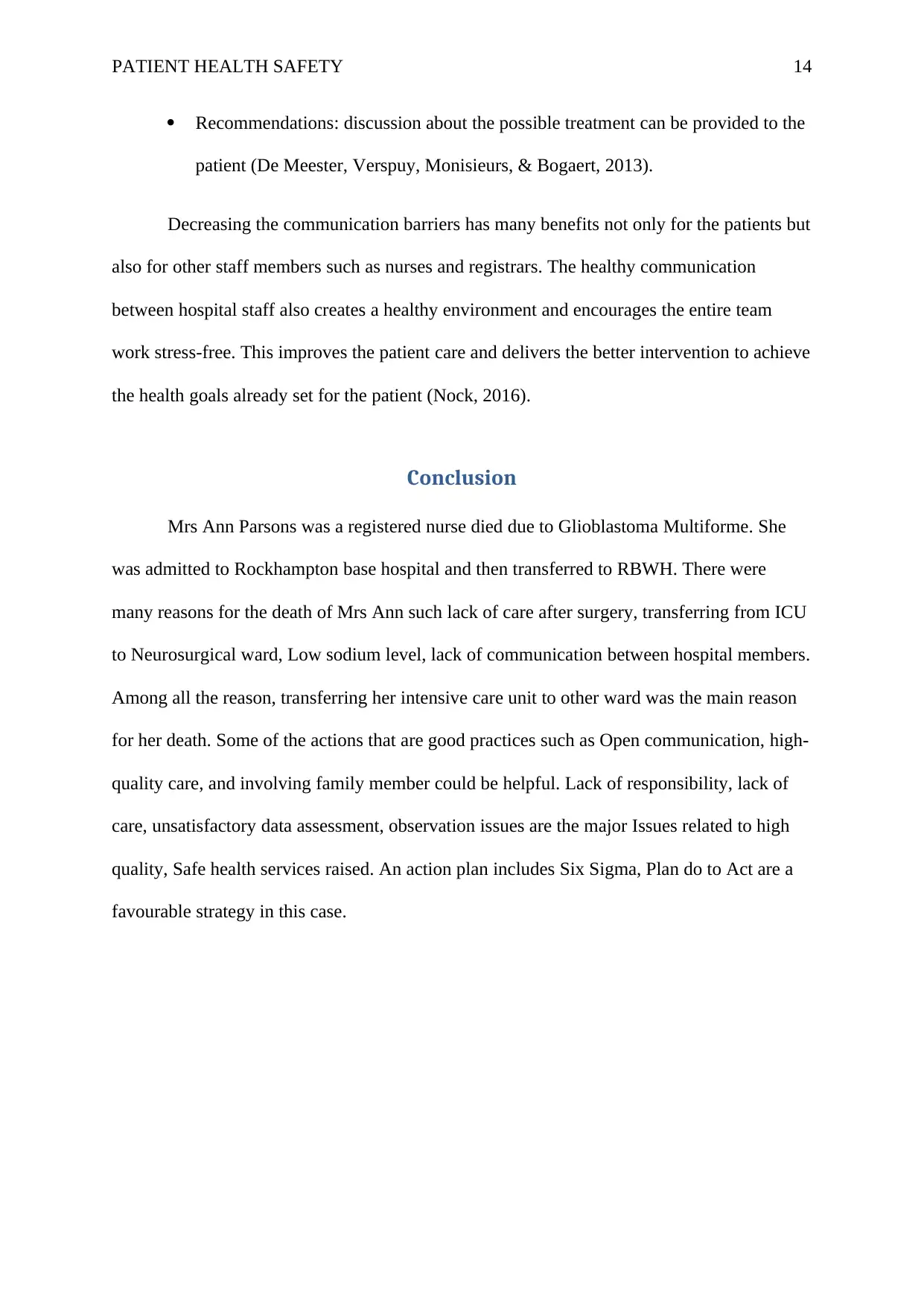
PATIENT HEALTH SAFETY 14
Recommendations: discussion about the possible treatment can be provided to the
patient (De Meester, Verspuy, Monisieurs, & Bogaert, 2013).
Decreasing the communication barriers has many benefits not only for the patients but
also for other staff members such as nurses and registrars. The healthy communication
between hospital staff also creates a healthy environment and encourages the entire team
work stress-free. This improves the patient care and delivers the better intervention to achieve
the health goals already set for the patient (Nock, 2016).
Conclusion
Mrs Ann Parsons was a registered nurse died due to Glioblastoma Multiforme. She
was admitted to Rockhampton base hospital and then transferred to RBWH. There were
many reasons for the death of Mrs Ann such lack of care after surgery, transferring from ICU
to Neurosurgical ward, Low sodium level, lack of communication between hospital members.
Among all the reason, transferring her intensive care unit to other ward was the main reason
for her death. Some of the actions that are good practices such as Open communication, high-
quality care, and involving family member could be helpful. Lack of responsibility, lack of
care, unsatisfactory data assessment, observation issues are the major Issues related to high
quality, Safe health services raised. An action plan includes Six Sigma, Plan do to Act are a
favourable strategy in this case.
Recommendations: discussion about the possible treatment can be provided to the
patient (De Meester, Verspuy, Monisieurs, & Bogaert, 2013).
Decreasing the communication barriers has many benefits not only for the patients but
also for other staff members such as nurses and registrars. The healthy communication
between hospital staff also creates a healthy environment and encourages the entire team
work stress-free. This improves the patient care and delivers the better intervention to achieve
the health goals already set for the patient (Nock, 2016).
Conclusion
Mrs Ann Parsons was a registered nurse died due to Glioblastoma Multiforme. She
was admitted to Rockhampton base hospital and then transferred to RBWH. There were
many reasons for the death of Mrs Ann such lack of care after surgery, transferring from ICU
to Neurosurgical ward, Low sodium level, lack of communication between hospital members.
Among all the reason, transferring her intensive care unit to other ward was the main reason
for her death. Some of the actions that are good practices such as Open communication, high-
quality care, and involving family member could be helpful. Lack of responsibility, lack of
care, unsatisfactory data assessment, observation issues are the major Issues related to high
quality, Safe health services raised. An action plan includes Six Sigma, Plan do to Act are a
favourable strategy in this case.
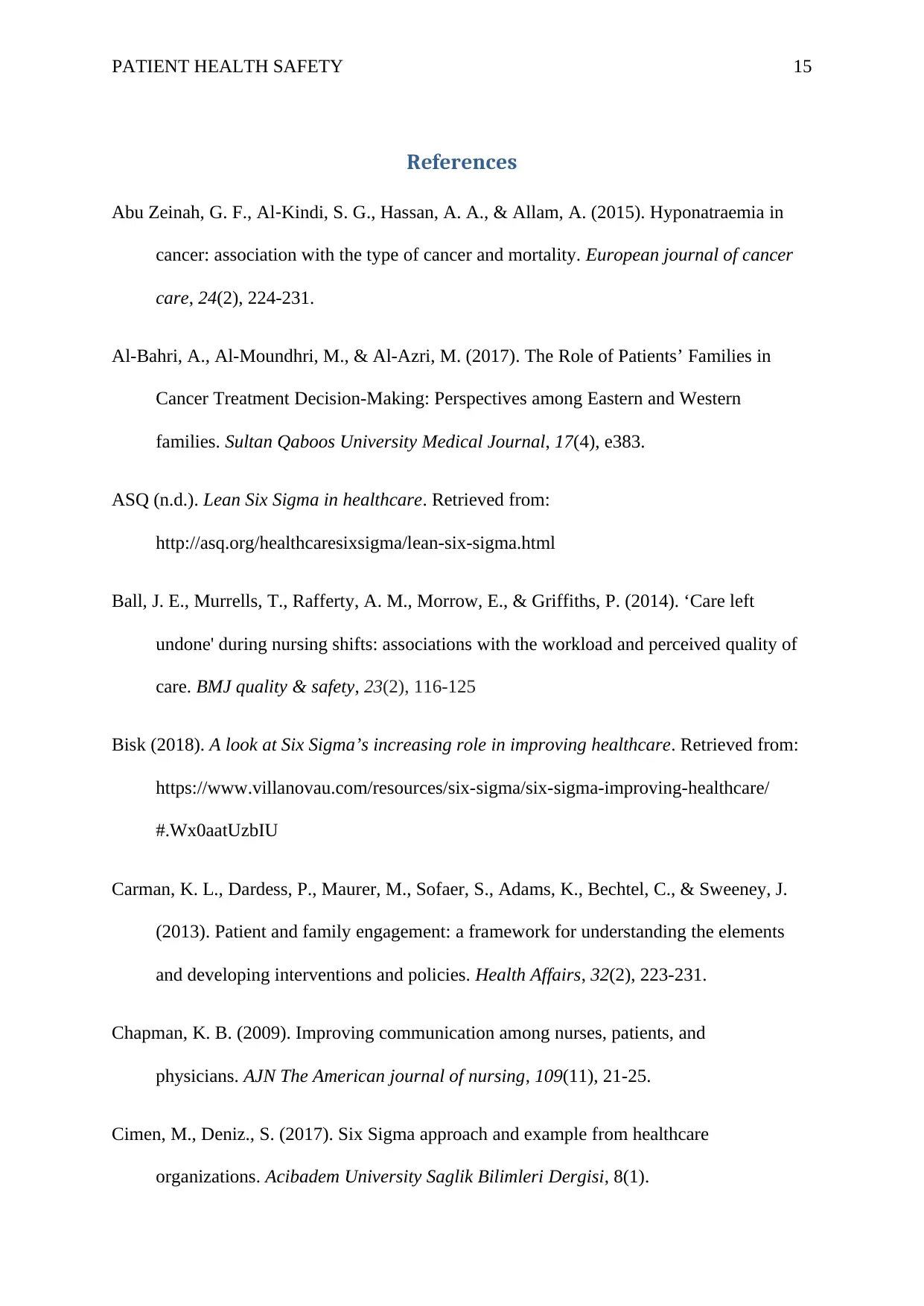
PATIENT HEALTH SAFETY 15
References
Abu Zeinah, G. F., Al‐Kindi, S. G., Hassan, A. A., & Allam, A. (2015). Hyponatraemia in
cancer: association with the type of cancer and mortality. European journal of cancer
care, 24(2), 224-231.
Al-Bahri, A., Al-Moundhri, M., & Al-Azri, M. (2017). The Role of Patients’ Families in
Cancer Treatment Decision-Making: Perspectives among Eastern and Western
families. Sultan Qaboos University Medical Journal, 17(4), e383.
ASQ (n.d.). Lean Six Sigma in healthcare. Retrieved from:
http://asq.org/healthcaresixsigma/lean-six-sigma.html
Ball, J. E., Murrells, T., Rafferty, A. M., Morrow, E., & Griffiths, P. (2014). ‘Care left
undone' during nursing shifts: associations with the workload and perceived quality of
care. BMJ quality & safety, 23(2), 116-125
Bisk (2018). A look at Six Sigma’s increasing role in improving healthcare. Retrieved from:
https://www.villanovau.com/resources/six-sigma/six-sigma-improving-healthcare/
#.Wx0aatUzbIU
Carman, K. L., Dardess, P., Maurer, M., Sofaer, S., Adams, K., Bechtel, C., & Sweeney, J.
(2013). Patient and family engagement: a framework for understanding the elements
and developing interventions and policies. Health Affairs, 32(2), 223-231.
Chapman, K. B. (2009). Improving communication among nurses, patients, and
physicians. AJN The American journal of nursing, 109(11), 21-25.
Cimen, M., Deniz., S. (2017). Six Sigma approach and example from healthcare
organizations. Acibadem University Saglik Bilimleri Dergisi, 8(1).
References
Abu Zeinah, G. F., Al‐Kindi, S. G., Hassan, A. A., & Allam, A. (2015). Hyponatraemia in
cancer: association with the type of cancer and mortality. European journal of cancer
care, 24(2), 224-231.
Al-Bahri, A., Al-Moundhri, M., & Al-Azri, M. (2017). The Role of Patients’ Families in
Cancer Treatment Decision-Making: Perspectives among Eastern and Western
families. Sultan Qaboos University Medical Journal, 17(4), e383.
ASQ (n.d.). Lean Six Sigma in healthcare. Retrieved from:
http://asq.org/healthcaresixsigma/lean-six-sigma.html
Ball, J. E., Murrells, T., Rafferty, A. M., Morrow, E., & Griffiths, P. (2014). ‘Care left
undone' during nursing shifts: associations with the workload and perceived quality of
care. BMJ quality & safety, 23(2), 116-125
Bisk (2018). A look at Six Sigma’s increasing role in improving healthcare. Retrieved from:
https://www.villanovau.com/resources/six-sigma/six-sigma-improving-healthcare/
#.Wx0aatUzbIU
Carman, K. L., Dardess, P., Maurer, M., Sofaer, S., Adams, K., Bechtel, C., & Sweeney, J.
(2013). Patient and family engagement: a framework for understanding the elements
and developing interventions and policies. Health Affairs, 32(2), 223-231.
Chapman, K. B. (2009). Improving communication among nurses, patients, and
physicians. AJN The American journal of nursing, 109(11), 21-25.
Cimen, M., Deniz., S. (2017). Six Sigma approach and example from healthcare
organizations. Acibadem University Saglik Bilimleri Dergisi, 8(1).
Secure Best Marks with AI Grader
Need help grading? Try our AI Grader for instant feedback on your assignments.
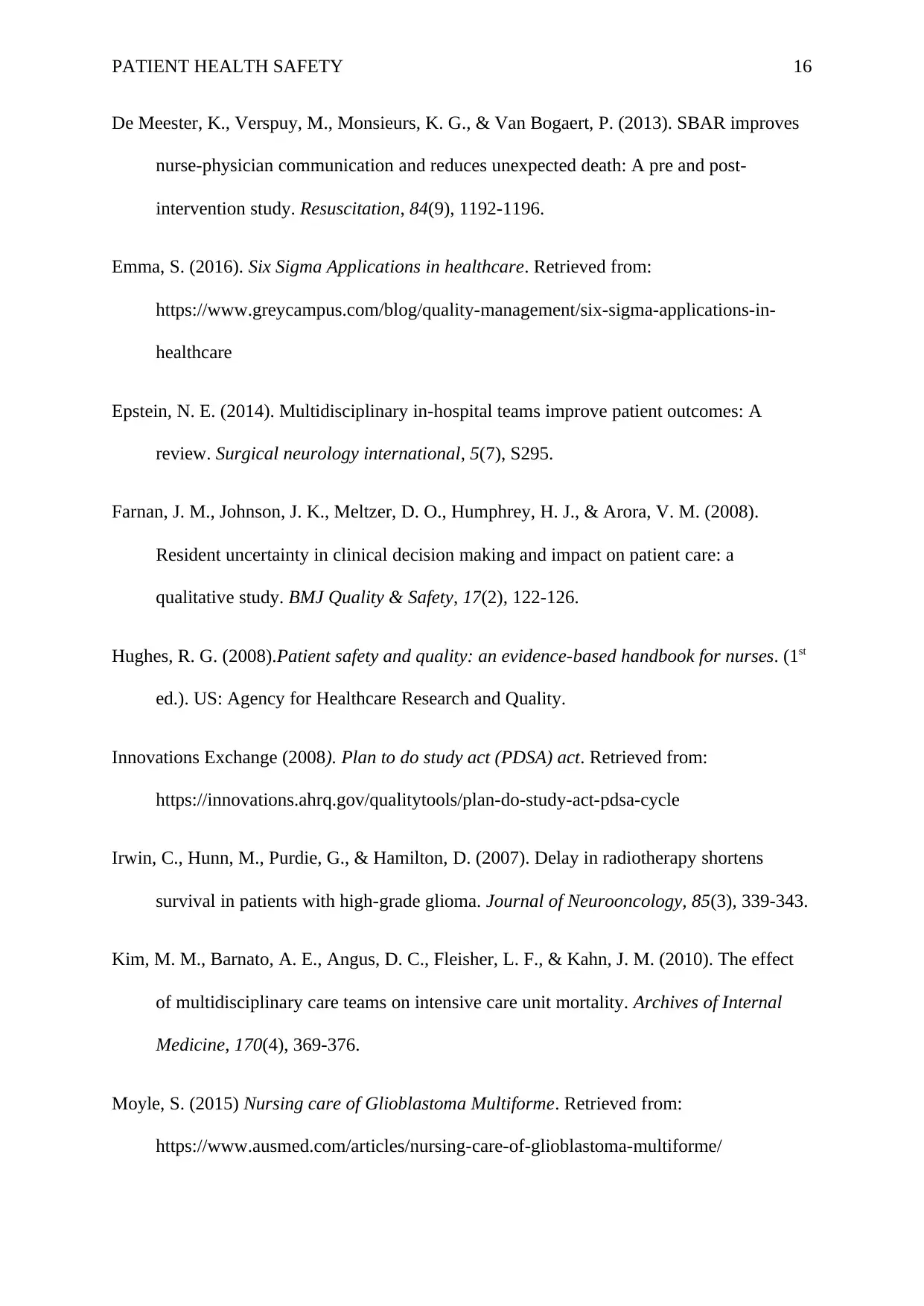
PATIENT HEALTH SAFETY 16
De Meester, K., Verspuy, M., Monsieurs, K. G., & Van Bogaert, P. (2013). SBAR improves
nurse-physician communication and reduces unexpected death: A pre and post-
intervention study. Resuscitation, 84(9), 1192-1196.
Emma, S. (2016). Six Sigma Applications in healthcare. Retrieved from:
https://www.greycampus.com/blog/quality-management/six-sigma-applications-in-
healthcare
Epstein, N. E. (2014). Multidisciplinary in-hospital teams improve patient outcomes: A
review. Surgical neurology international, 5(7), S295.
Farnan, J. M., Johnson, J. K., Meltzer, D. O., Humphrey, H. J., & Arora, V. M. (2008).
Resident uncertainty in clinical decision making and impact on patient care: a
qualitative study. BMJ Quality & Safety, 17(2), 122-126.
Hughes, R. G. (2008).Patient safety and quality: an evidence-based handbook for nurses. (1st
ed.). US: Agency for Healthcare Research and Quality.
Innovations Exchange (2008). Plan to do study act (PDSA) act. Retrieved from:
https://innovations.ahrq.gov/qualitytools/plan-do-study-act-pdsa-cycle
Irwin, C., Hunn, M., Purdie, G., & Hamilton, D. (2007). Delay in radiotherapy shortens
survival in patients with high-grade glioma. Journal of Neurooncology, 85(3), 339-343.
Kim, M. M., Barnato, A. E., Angus, D. C., Fleisher, L. F., & Kahn, J. M. (2010). The effect
of multidisciplinary care teams on intensive care unit mortality. Archives of Internal
Medicine, 170(4), 369-376.
Moyle, S. (2015) Nursing care of Glioblastoma Multiforme. Retrieved from:
https://www.ausmed.com/articles/nursing-care-of-glioblastoma-multiforme/
De Meester, K., Verspuy, M., Monsieurs, K. G., & Van Bogaert, P. (2013). SBAR improves
nurse-physician communication and reduces unexpected death: A pre and post-
intervention study. Resuscitation, 84(9), 1192-1196.
Emma, S. (2016). Six Sigma Applications in healthcare. Retrieved from:
https://www.greycampus.com/blog/quality-management/six-sigma-applications-in-
healthcare
Epstein, N. E. (2014). Multidisciplinary in-hospital teams improve patient outcomes: A
review. Surgical neurology international, 5(7), S295.
Farnan, J. M., Johnson, J. K., Meltzer, D. O., Humphrey, H. J., & Arora, V. M. (2008).
Resident uncertainty in clinical decision making and impact on patient care: a
qualitative study. BMJ Quality & Safety, 17(2), 122-126.
Hughes, R. G. (2008).Patient safety and quality: an evidence-based handbook for nurses. (1st
ed.). US: Agency for Healthcare Research and Quality.
Innovations Exchange (2008). Plan to do study act (PDSA) act. Retrieved from:
https://innovations.ahrq.gov/qualitytools/plan-do-study-act-pdsa-cycle
Irwin, C., Hunn, M., Purdie, G., & Hamilton, D. (2007). Delay in radiotherapy shortens
survival in patients with high-grade glioma. Journal of Neurooncology, 85(3), 339-343.
Kim, M. M., Barnato, A. E., Angus, D. C., Fleisher, L. F., & Kahn, J. M. (2010). The effect
of multidisciplinary care teams on intensive care unit mortality. Archives of Internal
Medicine, 170(4), 369-376.
Moyle, S. (2015) Nursing care of Glioblastoma Multiforme. Retrieved from:
https://www.ausmed.com/articles/nursing-care-of-glioblastoma-multiforme/
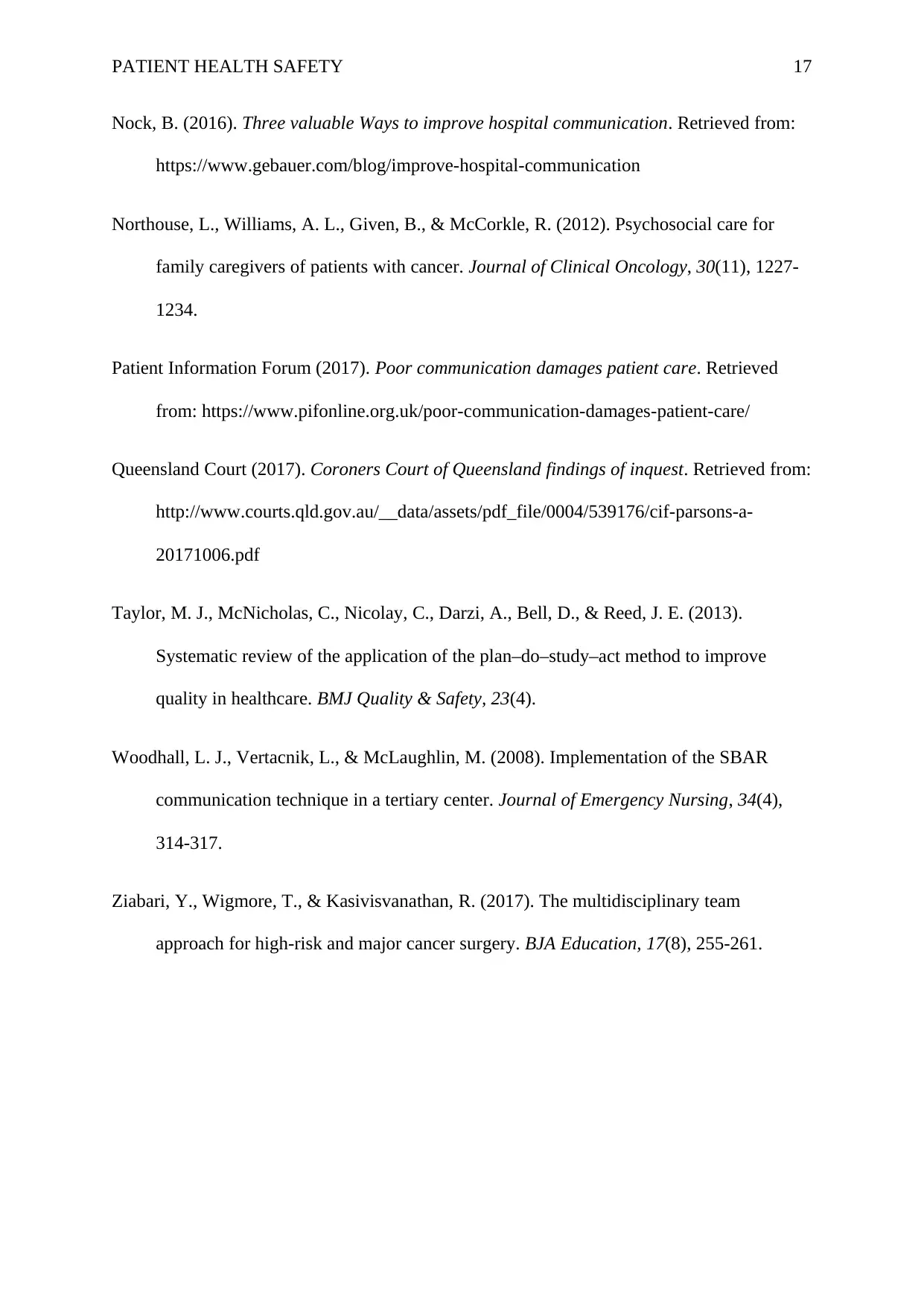
PATIENT HEALTH SAFETY 17
Nock, B. (2016). Three valuable Ways to improve hospital communication. Retrieved from:
https://www.gebauer.com/blog/improve-hospital-communication
Northouse, L., Williams, A. L., Given, B., & McCorkle, R. (2012). Psychosocial care for
family caregivers of patients with cancer. Journal of Clinical Oncology, 30(11), 1227-
1234.
Patient Information Forum (2017). Poor communication damages patient care. Retrieved
from: https://www.pifonline.org.uk/poor-communication-damages-patient-care/
Queensland Court (2017). Coroners Court of Queensland findings of inquest. Retrieved from:
http://www.courts.qld.gov.au/__data/assets/pdf_file/0004/539176/cif-parsons-a-
20171006.pdf
Taylor, M. J., McNicholas, C., Nicolay, C., Darzi, A., Bell, D., & Reed, J. E. (2013).
Systematic review of the application of the plan–do–study–act method to improve
quality in healthcare. BMJ Quality & Safety, 23(4).
Woodhall, L. J., Vertacnik, L., & McLaughlin, M. (2008). Implementation of the SBAR
communication technique in a tertiary center. Journal of Emergency Nursing, 34(4),
314-317.
Ziabari, Y., Wigmore, T., & Kasivisvanathan, R. (2017). The multidisciplinary team
approach for high-risk and major cancer surgery. BJA Education, 17(8), 255-261.
Nock, B. (2016). Three valuable Ways to improve hospital communication. Retrieved from:
https://www.gebauer.com/blog/improve-hospital-communication
Northouse, L., Williams, A. L., Given, B., & McCorkle, R. (2012). Psychosocial care for
family caregivers of patients with cancer. Journal of Clinical Oncology, 30(11), 1227-
1234.
Patient Information Forum (2017). Poor communication damages patient care. Retrieved
from: https://www.pifonline.org.uk/poor-communication-damages-patient-care/
Queensland Court (2017). Coroners Court of Queensland findings of inquest. Retrieved from:
http://www.courts.qld.gov.au/__data/assets/pdf_file/0004/539176/cif-parsons-a-
20171006.pdf
Taylor, M. J., McNicholas, C., Nicolay, C., Darzi, A., Bell, D., & Reed, J. E. (2013).
Systematic review of the application of the plan–do–study–act method to improve
quality in healthcare. BMJ Quality & Safety, 23(4).
Woodhall, L. J., Vertacnik, L., & McLaughlin, M. (2008). Implementation of the SBAR
communication technique in a tertiary center. Journal of Emergency Nursing, 34(4),
314-317.
Ziabari, Y., Wigmore, T., & Kasivisvanathan, R. (2017). The multidisciplinary team
approach for high-risk and major cancer surgery. BJA Education, 17(8), 255-261.
1 out of 18
Your All-in-One AI-Powered Toolkit for Academic Success.
+13062052269
info@desklib.com
Available 24*7 on WhatsApp / Email
![[object Object]](/_next/static/media/star-bottom.7253800d.svg)
Unlock your academic potential
© 2024 | Zucol Services PVT LTD | All rights reserved.

